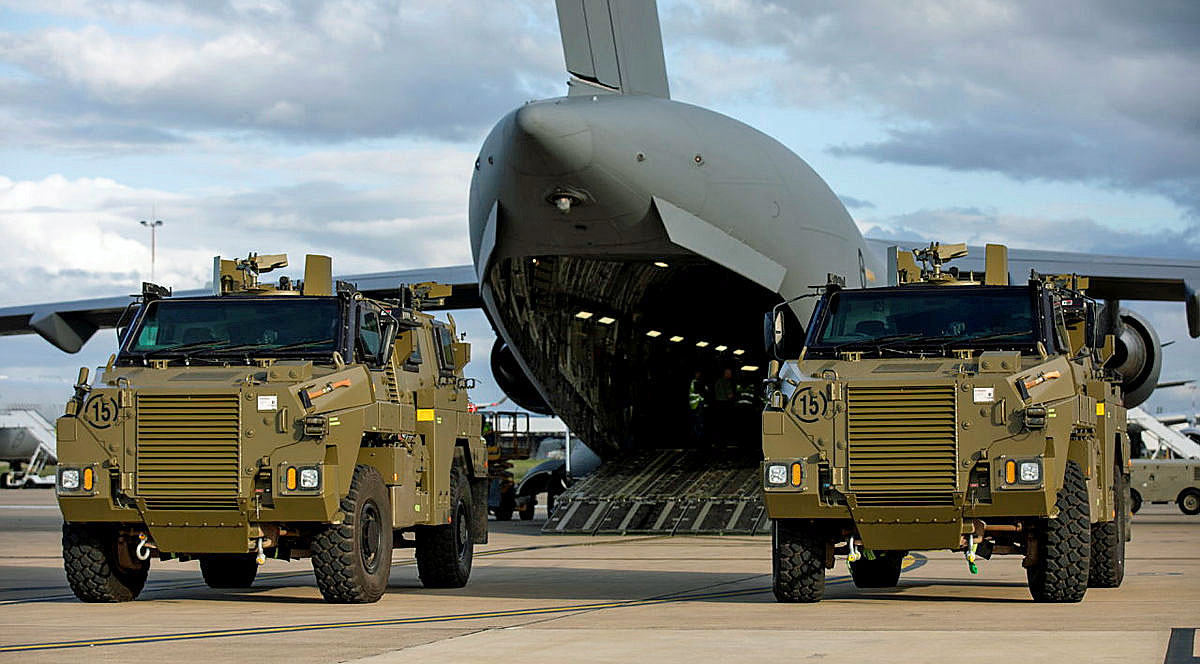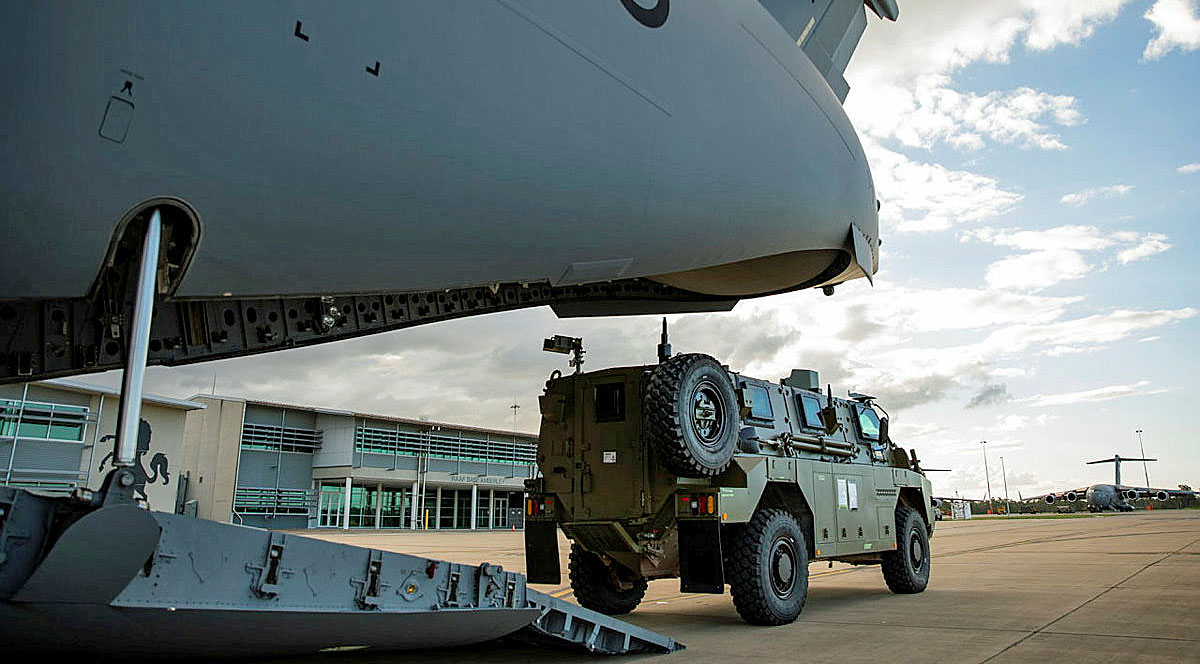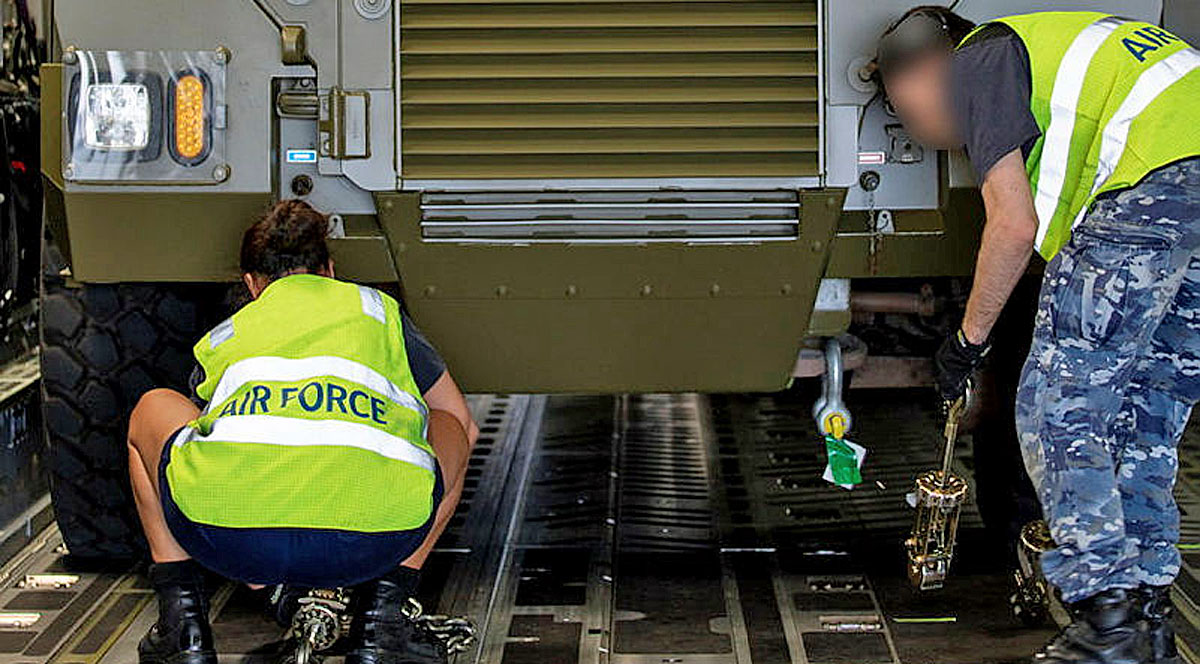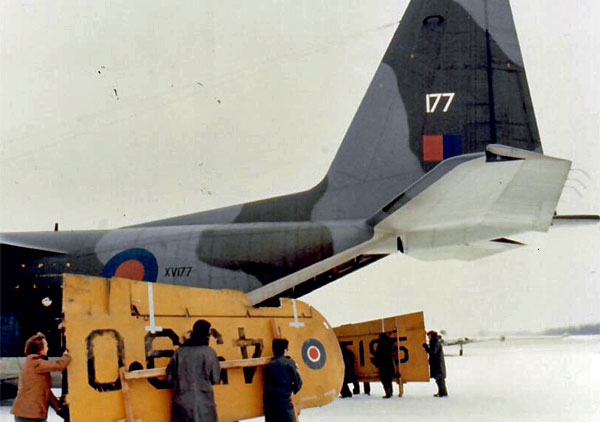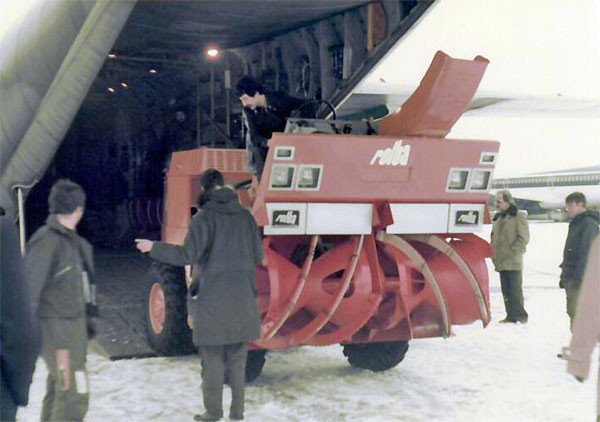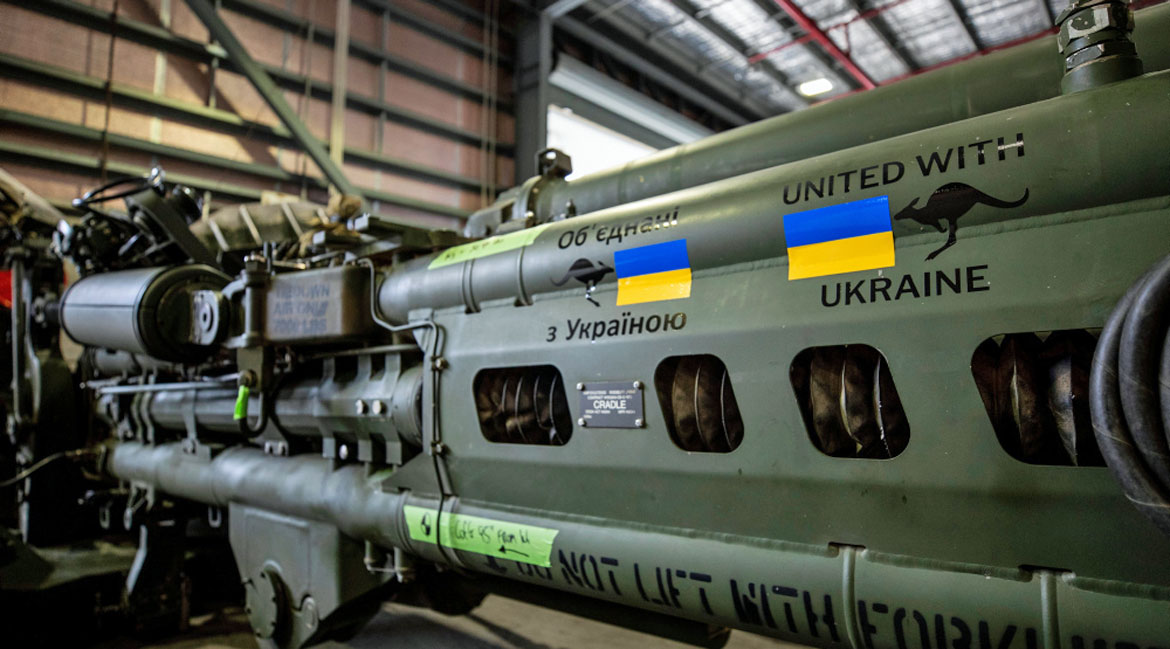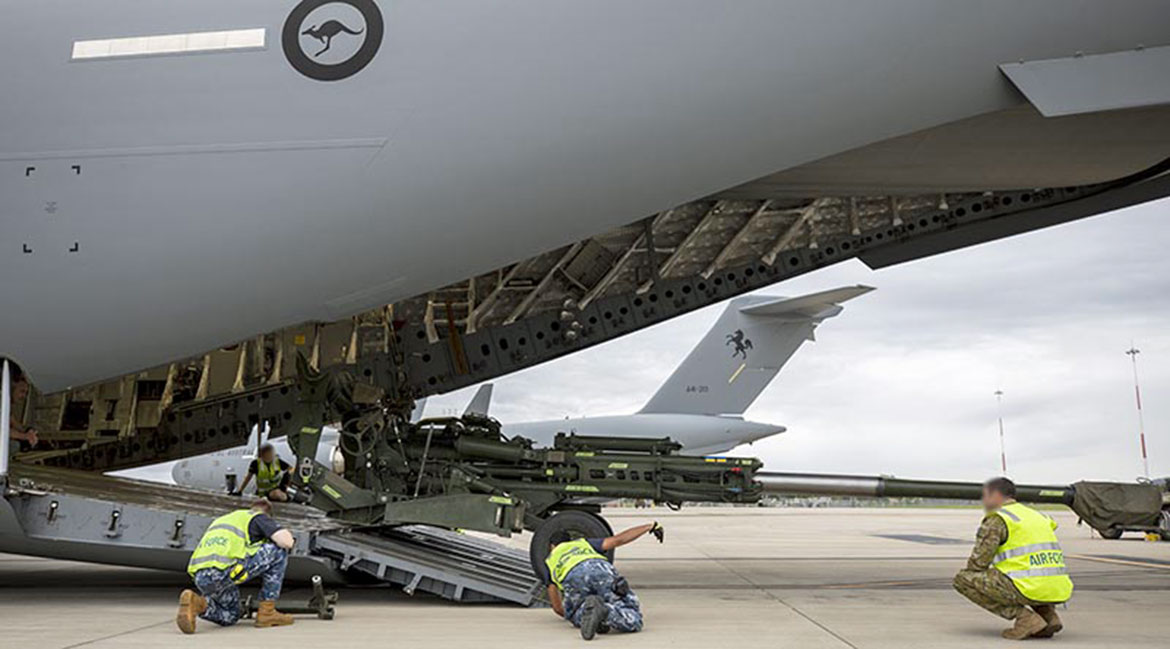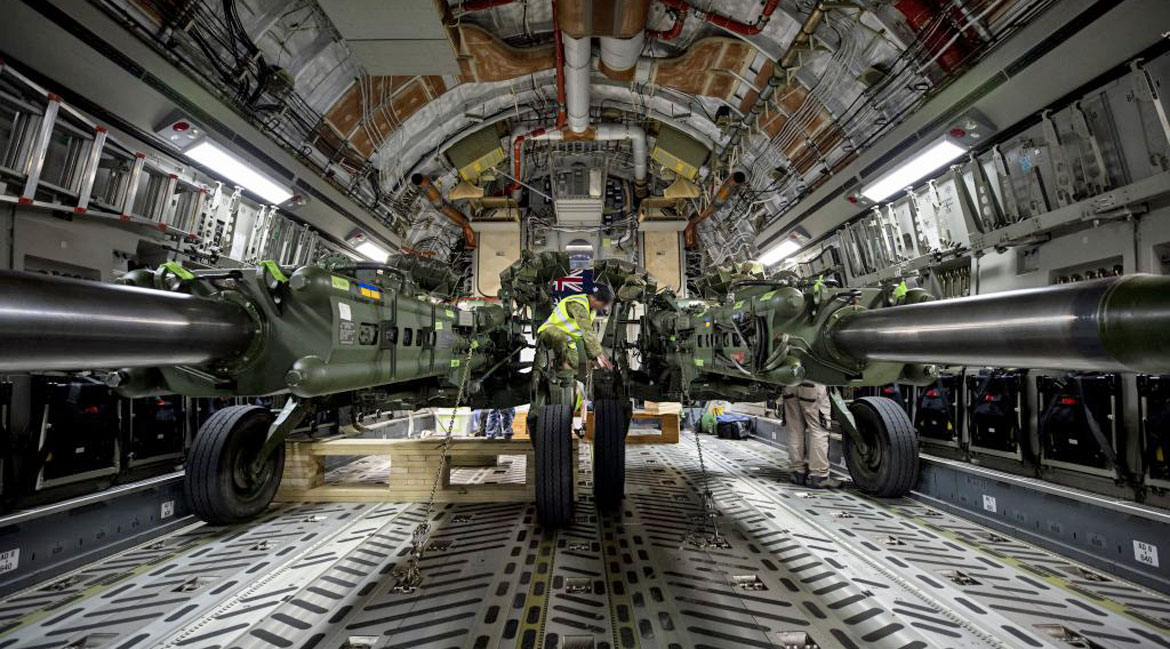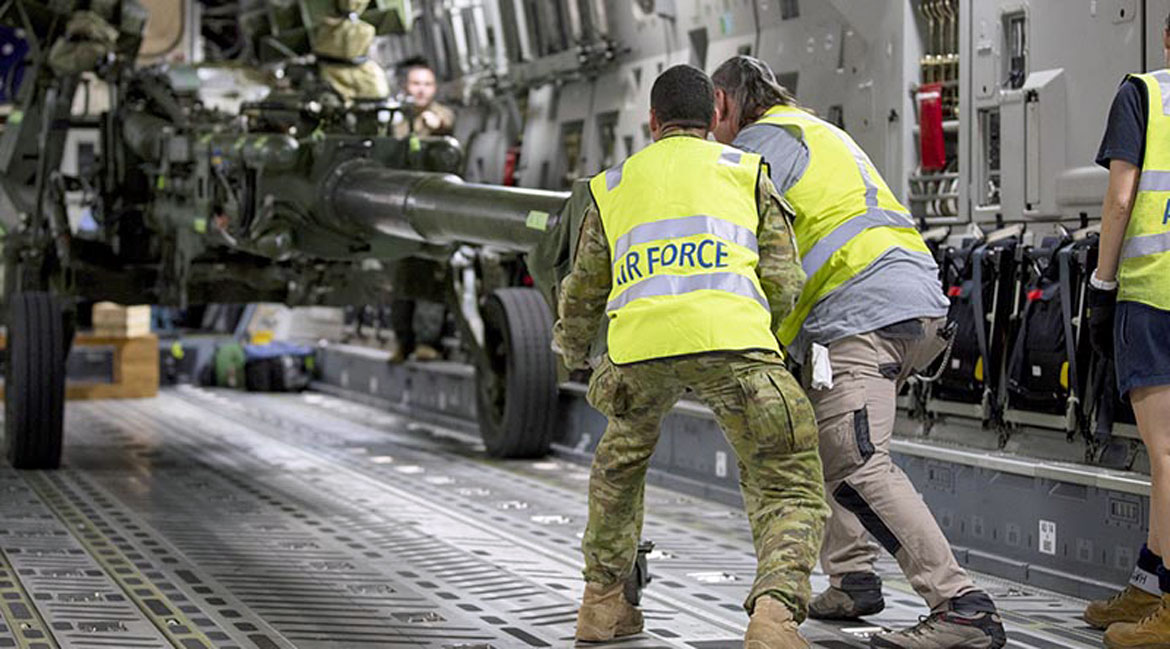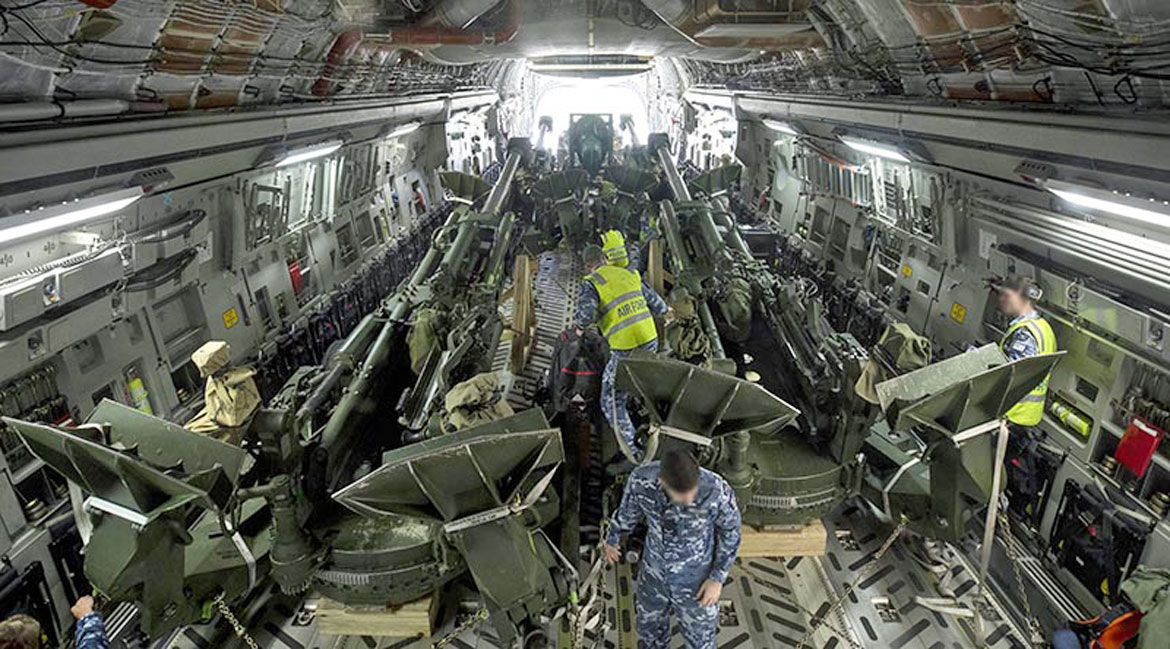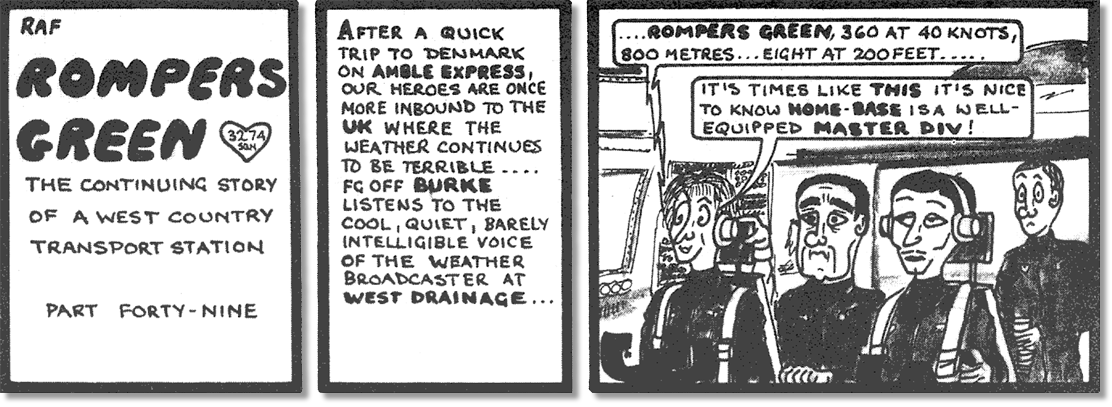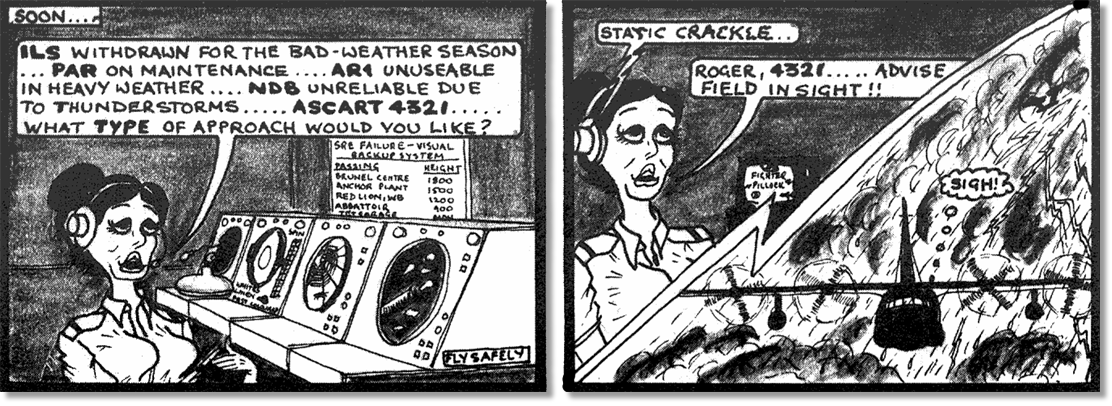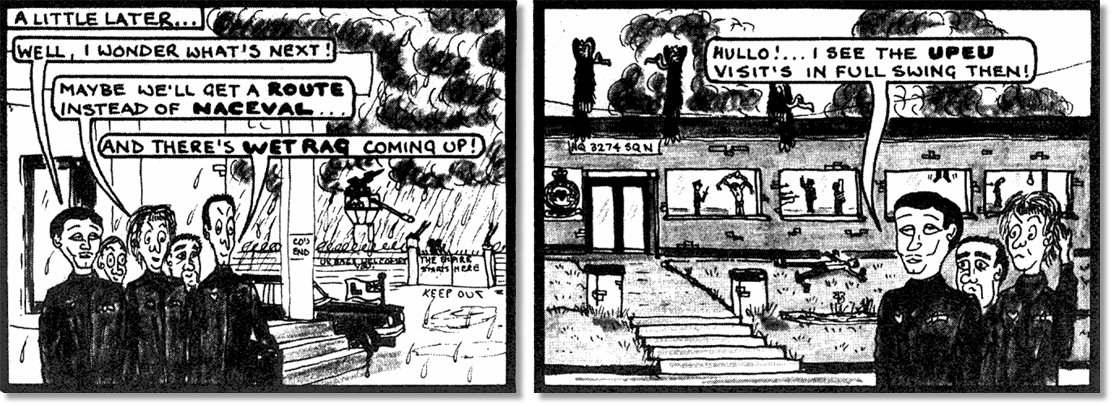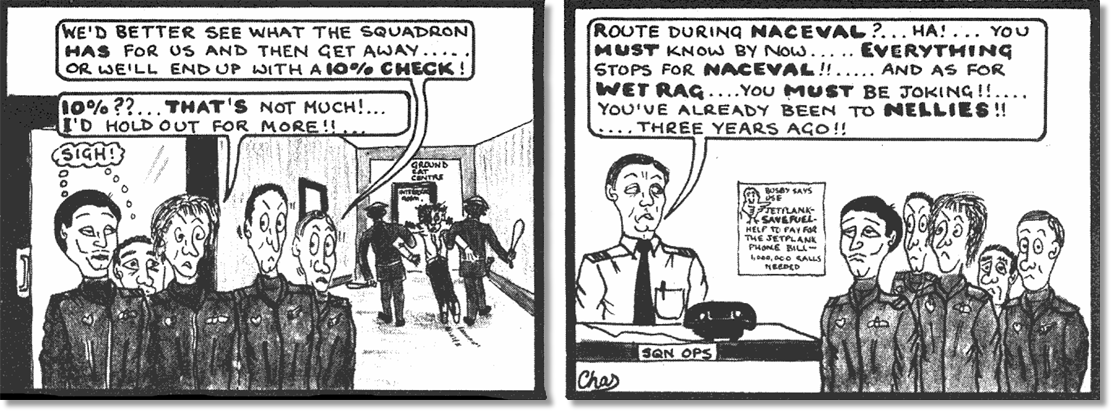

Kiwis have been spotted in Brize Norton
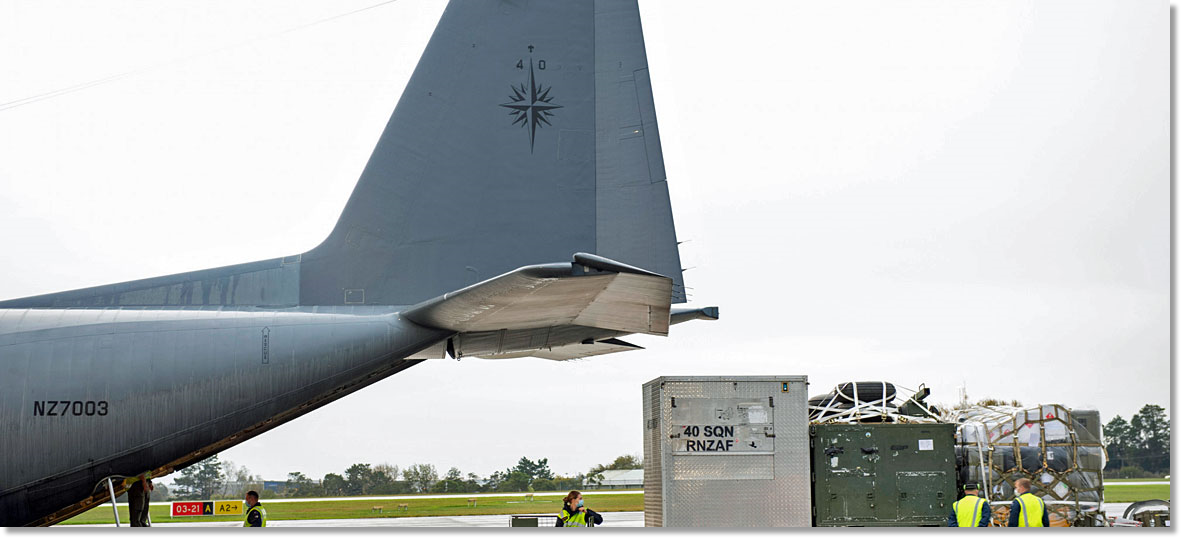
NZ7003 being prepared for departure from Auckland en route to Brize Norton
Our Royal New Zealand Air Force Hercules aircraft and crew arrived in the United Kingdom on April 18th ready to soon begin transporting donated military aid between centres in Europe. The majority of the approximately 50-strong air detachment arrived independently to Brize Norton in advance of the aircraft’s arrival, to start preparation for the movement of donated military aid.
Among this group are alternative flying crew, maintenance technicians and two air load teams who will manage the cargo loads for the aircraft. The two air load teams will also be able to assist with cargo movements on partner military aircraft.
Base Commander Auckland, Group Captain Andy Scott said, “We should never underestimate the value we can provide to partners with the contribution of a cargo aircraft and a team of professional, highly motivated service personnel. In situations like this airlift, logistics support and intelligence analysts are always key enablers and we are proud to be able to help.”
Among this group are alternative flying crew, maintenance technicians and two air load teams who will manage the cargo loads for the aircraft. The two air load teams will also be able to assist with cargo movements on partner military aircraft.
Base Commander Auckland, Group Captain Andy Scott said, “We should never underestimate the value we can provide to partners with the contribution of a cargo aircraft and a team of professional, highly motivated service personnel. In situations like this airlift, logistics support and intelligence analysts are always key enablers and we are proud to be able to help.”
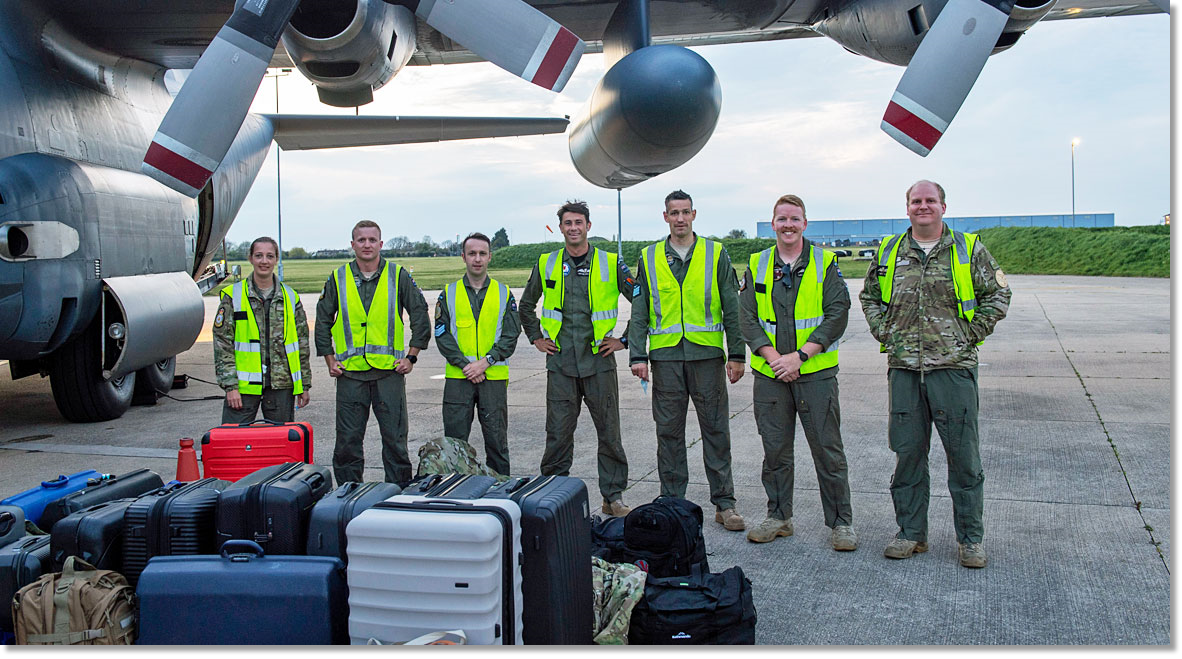
nzdf.mil.nz

From: Glen Falardeau, Edmonton, AB
Subject: Re: UKMAMS OBA OBB #033122
Hello Tony,
I really liked the nice intro with the blue skies over a ripe Canola field signifying the end to a long Winter. I don't know about the UK but here in Alberta it sure hit home.
Also and right after the next item was an even nicer touch by reaching out to Mark Attrill in Tallinn for a broad viewpoint from his perspective since retiring and being re-hired in the heat of the action ensuing and during the ongoing uncalled massacre, leveling of cities and who knows what else against his own people and territories whom and of which supposedly belong back to "him". Most enlightening (and frightening might I add) reply on his part.
So frustrating to see the "war" evolve without being able to do anything more meaningful without upsetting Mr. ready-to-go nuclear if you piss him off.
I must commend Tony Street for two great articles, two amongst a good pile up of course.
Hey Tony , whatever happened to having access to the World map to find where so-and-so is located?
Once again thank you for a great edition of your Newsletter. Much like my copy of the Legion Magazine, I can't wait to get it.
Best regards,
Glen Falardeau
Kipnes Center for Veterans,
Edmonton AB, Canada
Subject: Re: UKMAMS OBA OBB #033122
Hello Tony,
I really liked the nice intro with the blue skies over a ripe Canola field signifying the end to a long Winter. I don't know about the UK but here in Alberta it sure hit home.
Also and right after the next item was an even nicer touch by reaching out to Mark Attrill in Tallinn for a broad viewpoint from his perspective since retiring and being re-hired in the heat of the action ensuing and during the ongoing uncalled massacre, leveling of cities and who knows what else against his own people and territories whom and of which supposedly belong back to "him". Most enlightening (and frightening might I add) reply on his part.
So frustrating to see the "war" evolve without being able to do anything more meaningful without upsetting Mr. ready-to-go nuclear if you piss him off.
I must commend Tony Street for two great articles, two amongst a good pile up of course.
Hey Tony , whatever happened to having access to the World map to find where so-and-so is located?
Once again thank you for a great edition of your Newsletter. Much like my copy of the Legion Magazine, I can't wait to get it.
Best regards,
Glen Falardeau
Kipnes Center for Veterans,
Edmonton AB, Canada

From: Tony Gale, Gatineau, QC
Subject: RE: UKMAMS OBA OBB #033122
Hi Glen,
It’s good to hear from you.
Thanks for the kind words about the newsletter – although it wouldn’t happen without the submissions from the members, so I can’t take all the credit!
That was a great interpretation of yours of the cover picture with blue sky and canola field announcing the arrival of Spring on the Canadian Prairies – but that really wasn’t my intent. It is supposed to represent the blue and yellow of the Ukrainian flag as a show of support for all those poor people over there.
In the meantime – the OBA Earth Map is still out there, although it’s taking me some time to get all of the faces against the pins. It’s best to view it using the Firefox browser: https://batchgeo.com/map/oba_earth [The password was sent to Glen, if you need reminding of it, send me an e-mail]
Best regards
Tony
Subject: RE: UKMAMS OBA OBB #033122
Hi Glen,
It’s good to hear from you.
Thanks for the kind words about the newsletter – although it wouldn’t happen without the submissions from the members, so I can’t take all the credit!
That was a great interpretation of yours of the cover picture with blue sky and canola field announcing the arrival of Spring on the Canadian Prairies – but that really wasn’t my intent. It is supposed to represent the blue and yellow of the Ukrainian flag as a show of support for all those poor people over there.
In the meantime – the OBA Earth Map is still out there, although it’s taking me some time to get all of the faces against the pins. It’s best to view it using the Firefox browser: https://batchgeo.com/map/oba_earth [The password was sent to Glen, if you need reminding of it, send me an e-mail]
Best regards
Tony


From: Michael Cocker, Swindon, Wilts
Subject: Re: UKMAMS OBA OBB #033122
Hi Tony,
In response to John Gillis' question about the Naval contingent at Gatwick Airport in 86/87. I should know his name as I was at Heathrow over that period, as Ian Berry says, part of JSATC Hendon, although by that time we we prepping for the move to RAF Stanbridge in 1988. Kev Skelton was the RAF Cpl at Gatwick so he would definitely know, as may Paul Saunders or Taff Isaac who were at LHR at the same time.
We had a Leading Regulator (Dick Lawless) with us, while the Gatwick Detachment had a PO (Reg), with a CPO (MAA) at the HQ. If I come up with the Gatwick PO's name I'll let you know. While at Luton Airport we had a Naval Airman (Bungy Williams), who was the instigator of many a drunken adventure - I won't go into print on these though, as they may be subject to the 100 year rule on the Official Secrets Act, and it may also generate one or two angry wives!
Cheers
Mick
Subject: Re: UKMAMS OBA OBB #033122
Hi Tony,
In response to John Gillis' question about the Naval contingent at Gatwick Airport in 86/87. I should know his name as I was at Heathrow over that period, as Ian Berry says, part of JSATC Hendon, although by that time we we prepping for the move to RAF Stanbridge in 1988. Kev Skelton was the RAF Cpl at Gatwick so he would definitely know, as may Paul Saunders or Taff Isaac who were at LHR at the same time.
We had a Leading Regulator (Dick Lawless) with us, while the Gatwick Detachment had a PO (Reg), with a CPO (MAA) at the HQ. If I come up with the Gatwick PO's name I'll let you know. While at Luton Airport we had a Naval Airman (Bungy Williams), who was the instigator of many a drunken adventure - I won't go into print on these though, as they may be subject to the 100 year rule on the Official Secrets Act, and it may also generate one or two angry wives!
Cheers
Mick


From: Mark Attrill, Tallinn
Subject: The Duty Free Run
Hi Tony,
It was back in 1983/84 and there were some changes to the Duty Free regulations which prevented operating aircrew from bringing in a full allowance each and every time they flew overseas and especially on 'day trips'. If I recall correctly, they had to split an individual standard allowance (1 x bottle of spirit, 3 x bottles of wine and 200 cigarettes) between the entire crew. UKMAMS personnel, on the other hand, were able to bring in the standard allowance for each person, regardless of the duration of the trip. There was, inevitably, a lot of 'chimpfing' going on within the Station leadership and I remember the Boss (Bob Dixon) regularly coming back from the Station Commanders 'morning prayers' having had his ear bent by the Flying Squadron Commanders about how unfair all of this was.
As always, there were good and bad crews and with the former, we always managed to find the middle ground and share allowances. As a non-smoker, I often 'gave' my cigarette allowance to the Loadie if he had been particularly helpful and cooperative, for example. Other times it was not so good and I well remember one three-day trip to Germany with Al Skarisbrick and Paddy Power during which we were constantly berated by a particularly aggressive ALM about the aforementioned disparity over DF allowances between aircrew and UKMAMS personnel. I had already agreed to a couple of exchanges within the team, which resulted in someone (I cannot remember if it was Al or Paddy) taking three bottles of spirit, the other taking 600 cigarettes and my ending up with 9 bottles of wine.
After we arrived back at Lyneham and were waiting to go through Customs, this particular Loadie got all smug about the fact that I would get charged for having too many bottles of wine since he had also has assumed I still had my bottle & '200'. I told him not to worry - he had obviously forgotten or not realised that 1/2/200 was our 'daily' DF rate and having been away 3 days, I was entitled to 9 bottles of wine! Of course, my subsequent 'wave through' customs only served to reinforce this notion and, knowing how Aircrew scuttlebut worked overtime on such issues, word quickly got around the Station, which generated another storm of protest - Happy Days winding up certain 'categories' of aircrew.
Cheers
Mark
Subject: The Duty Free Run
Hi Tony,
It was back in 1983/84 and there were some changes to the Duty Free regulations which prevented operating aircrew from bringing in a full allowance each and every time they flew overseas and especially on 'day trips'. If I recall correctly, they had to split an individual standard allowance (1 x bottle of spirit, 3 x bottles of wine and 200 cigarettes) between the entire crew. UKMAMS personnel, on the other hand, were able to bring in the standard allowance for each person, regardless of the duration of the trip. There was, inevitably, a lot of 'chimpfing' going on within the Station leadership and I remember the Boss (Bob Dixon) regularly coming back from the Station Commanders 'morning prayers' having had his ear bent by the Flying Squadron Commanders about how unfair all of this was.
As always, there were good and bad crews and with the former, we always managed to find the middle ground and share allowances. As a non-smoker, I often 'gave' my cigarette allowance to the Loadie if he had been particularly helpful and cooperative, for example. Other times it was not so good and I well remember one three-day trip to Germany with Al Skarisbrick and Paddy Power during which we were constantly berated by a particularly aggressive ALM about the aforementioned disparity over DF allowances between aircrew and UKMAMS personnel. I had already agreed to a couple of exchanges within the team, which resulted in someone (I cannot remember if it was Al or Paddy) taking three bottles of spirit, the other taking 600 cigarettes and my ending up with 9 bottles of wine.
After we arrived back at Lyneham and were waiting to go through Customs, this particular Loadie got all smug about the fact that I would get charged for having too many bottles of wine since he had also has assumed I still had my bottle & '200'. I told him not to worry - he had obviously forgotten or not realised that 1/2/200 was our 'daily' DF rate and having been away 3 days, I was entitled to 9 bottles of wine! Of course, my subsequent 'wave through' customs only served to reinforce this notion and, knowing how Aircrew scuttlebut worked overtime on such issues, word quickly got around the Station, which generated another storm of protest - Happy Days winding up certain 'categories' of aircrew.
Cheers
Mark


RAF Working to Deliver Vital Military Aid for Ukraine
The Air Mobility Force based at RAF Brize Norton have been working night and day to deliver vital military aid for Ukraine. The aid has been delivered by Globemaster C17 aircraft, which have flown over 60 aid missions so far.

From: David Powell, Princes Risborough, Bucks
Subject: Strange Loads
Hi Tony,
You asked for memories of Strange Loads. Bearing in mind that the rock-crusher, bouncing howitzer and 25,000 mosquitoes sagas have already been consigned to the Old Bods Newsletters archives, I don't think I have mentioned moving a telephone exchange from Sharjah to Hong Kong.
For the last few months of the run down of the Gulf in 1971, Gulf MAMS had relocated to RAF Sharjah where most of our tasking was expected to be generated, e.g. lots of lovely Wessex helicopters loading onto Belfast freighters.
One evening in the bar I was approached to see if the RAF could move a shortly to be made redundant Army telephone exchange at Sharjah to Hong Kong? Sounded interesting, so off we went the next day to see what this was all about.
For those brought up in the microchip age, I should explain that radios used valves, music was played on large plastic discs at 33 rpm, and telephone calls were routed through connected hubs, called telephone exchanges. These contained rack upon rack of clickity clacking chunky relays which interpreted the dialing clicks of the incoming call to route it to the intended recipient's black Bakelite handset, such as as featured in TV series such as Morse.
Each exchange had its own code. One day, I vaguely recall stringing together a string of exchange codes, e.g. MoD to Upavon, Upavon to Odiham, Odiham to Mod, to call the guy the other side of the office!
This facility was quite useful when making illicit private phone calls by picking up a 'dial 9' outside line from another Service exchange. I digress.
A complication with this potential move was that ideally we were required to move the relay racks intact to speed its prompt activation in a new home in Hong Kong.
We worked out a cunning plan; as Sharjah was running down, stocks of redundant mattresses were building up. So we suggested moving the fragile racks, which were about 6 ft by 6ft by 10 inches on pallets between layers of mattresses, the ultimate club sandwich.
A couple of days before a convenient Hercules trainer in roller fit heading Eastwards would be calling by, we knocked a very large hole in the telephone exchange, big enough for a forklift truck. A stack of pallets were positioned onsite. The individual pallets were built in the now draughty exchange building, and then carefully trundled over to Air Cargo to await the airlift.
Of course, with such a complex and unproven load, we just had to send along a MAMS team for the offload. As well as supervising the move to and the onsite breakdown of the pallets. We also needed to ensure that the pallets were returned, at least to Kai Tak. We never found out what happened to the mattresses.
The task went like a dream. The only downside was being stuck in Kai Tak for several days waiting for a west bound ride back to Bahrain. But, it did mean we were able to spend a day with the Gurkhas up on the Bamboo Curtain. It just so happened that their Regiments CO was the brother of our Squadron Leader tasker at Gulf HQ!
Happy days!
David Powell, F Team UKMAMS 1967-69, GULF MAMF 1971.
Subject: Strange Loads
Hi Tony,
You asked for memories of Strange Loads. Bearing in mind that the rock-crusher, bouncing howitzer and 25,000 mosquitoes sagas have already been consigned to the Old Bods Newsletters archives, I don't think I have mentioned moving a telephone exchange from Sharjah to Hong Kong.
For the last few months of the run down of the Gulf in 1971, Gulf MAMS had relocated to RAF Sharjah where most of our tasking was expected to be generated, e.g. lots of lovely Wessex helicopters loading onto Belfast freighters.
One evening in the bar I was approached to see if the RAF could move a shortly to be made redundant Army telephone exchange at Sharjah to Hong Kong? Sounded interesting, so off we went the next day to see what this was all about.
For those brought up in the microchip age, I should explain that radios used valves, music was played on large plastic discs at 33 rpm, and telephone calls were routed through connected hubs, called telephone exchanges. These contained rack upon rack of clickity clacking chunky relays which interpreted the dialing clicks of the incoming call to route it to the intended recipient's black Bakelite handset, such as as featured in TV series such as Morse.
Each exchange had its own code. One day, I vaguely recall stringing together a string of exchange codes, e.g. MoD to Upavon, Upavon to Odiham, Odiham to Mod, to call the guy the other side of the office!
This facility was quite useful when making illicit private phone calls by picking up a 'dial 9' outside line from another Service exchange. I digress.
A complication with this potential move was that ideally we were required to move the relay racks intact to speed its prompt activation in a new home in Hong Kong.
We worked out a cunning plan; as Sharjah was running down, stocks of redundant mattresses were building up. So we suggested moving the fragile racks, which were about 6 ft by 6ft by 10 inches on pallets between layers of mattresses, the ultimate club sandwich.
A couple of days before a convenient Hercules trainer in roller fit heading Eastwards would be calling by, we knocked a very large hole in the telephone exchange, big enough for a forklift truck. A stack of pallets were positioned onsite. The individual pallets were built in the now draughty exchange building, and then carefully trundled over to Air Cargo to await the airlift.
Of course, with such a complex and unproven load, we just had to send along a MAMS team for the offload. As well as supervising the move to and the onsite breakdown of the pallets. We also needed to ensure that the pallets were returned, at least to Kai Tak. We never found out what happened to the mattresses.
The task went like a dream. The only downside was being stuck in Kai Tak for several days waiting for a west bound ride back to Bahrain. But, it did mean we were able to spend a day with the Gurkhas up on the Bamboo Curtain. It just so happened that their Regiments CO was the brother of our Squadron Leader tasker at Gulf HQ!
Happy days!
David Powell, F Team UKMAMS 1967-69, GULF MAMF 1971.


From: Bill Hall, Canberra, ACT
Subject: Strange Loads
Hi Tony,
Regarding your shipment of a dead tree - so it was you! When I was on OTS there was an exercise to ship a dead parrot from Oz to Masirah Island. I always wondered why or where the hell they got that idea from. Oh, by the way, we had it embalmed, sealed and managed to put it in a diplomatic bag. When given a problem you always have to think outside the box!
I bet all the teams are very busy now - if only I was 50 years younger!
Regards,
Bill
Subject: Strange Loads
Hi Tony,
Regarding your shipment of a dead tree - so it was you! When I was on OTS there was an exercise to ship a dead parrot from Oz to Masirah Island. I always wondered why or where the hell they got that idea from. Oh, by the way, we had it embalmed, sealed and managed to put it in a diplomatic bag. When given a problem you always have to think outside the box!
I bet all the teams are very busy now - if only I was 50 years younger!
Regards,
Bill


Further Australian Support for Ukraine
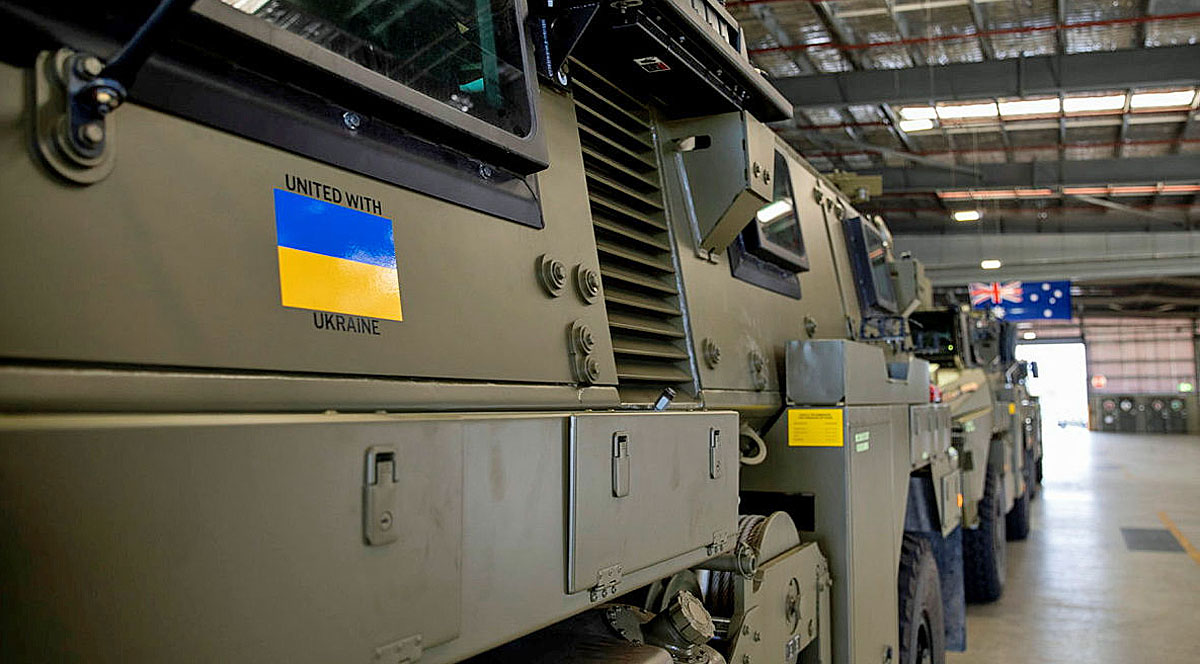
Canberra, 08 April 2022: The Australian Government will provide further support to the Government of Ukraine by gifting 20 Bushmaster protected mobility vehicles, including two ambulance variants, to aid the Government of Ukraine’s response to Russia’s unrelenting and illegal aggression. Australia’s response follows a direct request from President Zelenskyy during his address to the Australian Parliament on 31 March 2022.
The Bushmaster was built in Australia to provide protected mobility transport, safely moving soldiers to a battle area prior to dismounting for close combat. The Bushmaster is well suited to provide protection to the Ukrainian Armed Forces soldiers and Ukrainian civilians against mines and improvised explosive devices, shrapnel from artillery and small arms fire.
The 20 vehicles are painted olive green to suit the operating environment. Additionally, a Ukrainian flag is painted on either side with the words ‘United with Ukraine’ stencilled in English and Ukrainian to acknowledge our commitment and support to the government and people of Ukraine. The ambulances will have the traditional Red Cross emblem.
The Bushmaster will be fitted with radios, a global positioning system and additional bolt-on armour to increase their protection. Defence will continue to work with the Government of Ukraine to develop a suitable logistics support package, while training will be conducted through Army video training with Ukrainian subtitles.
To date, Australia has committed a total of around $116 million of defensive military assistance to Ukraine, the addition of these vehicles takes our commitment to around $165 million. In addition, Australia is delivering 70,000 tonnes of coal to power Ukraine’s resistance, on top of $65 million in humanitarian assistance for the people of Ukraine, with a focus on protecting women, children and the elderly, including for food, shelter and emergency medical supplies. Further specific details about delivery arrangements will not be disclosed following a request from Ukrainian officials and our other partners.
The Australian Government will continue to identify opportunities for further defensive military assistance where it is able to provide a required capability to the Ukraine Armed Forces expeditiously.
Australia stands with the Government and people of Ukraine, and calls on Russia to cease its unprovoked, unjust and illegal invasion of Ukraine. The Australian Government will continue to take steps, together with our partners, to ensure Russia pays the highest possible price for its actions.
joint-forces.com
The Bushmaster was built in Australia to provide protected mobility transport, safely moving soldiers to a battle area prior to dismounting for close combat. The Bushmaster is well suited to provide protection to the Ukrainian Armed Forces soldiers and Ukrainian civilians against mines and improvised explosive devices, shrapnel from artillery and small arms fire.
The 20 vehicles are painted olive green to suit the operating environment. Additionally, a Ukrainian flag is painted on either side with the words ‘United with Ukraine’ stencilled in English and Ukrainian to acknowledge our commitment and support to the government and people of Ukraine. The ambulances will have the traditional Red Cross emblem.
The Bushmaster will be fitted with radios, a global positioning system and additional bolt-on armour to increase their protection. Defence will continue to work with the Government of Ukraine to develop a suitable logistics support package, while training will be conducted through Army video training with Ukrainian subtitles.
To date, Australia has committed a total of around $116 million of defensive military assistance to Ukraine, the addition of these vehicles takes our commitment to around $165 million. In addition, Australia is delivering 70,000 tonnes of coal to power Ukraine’s resistance, on top of $65 million in humanitarian assistance for the people of Ukraine, with a focus on protecting women, children and the elderly, including for food, shelter and emergency medical supplies. Further specific details about delivery arrangements will not be disclosed following a request from Ukrainian officials and our other partners.
The Australian Government will continue to identify opportunities for further defensive military assistance where it is able to provide a required capability to the Ukraine Armed Forces expeditiously.
Australia stands with the Government and people of Ukraine, and calls on Russia to cease its unprovoked, unjust and illegal invasion of Ukraine. The Australian Government will continue to take steps, together with our partners, to ensure Russia pays the highest possible price for its actions.
joint-forces.com

From: Stephen Bird, Chester
Subject: Strange Loads
It's funny you should mention trees, as that was what my strangest load was!
It was Gutersloh in the mid 80's and someone had come up with the idea of utilising several empty Hercules back to the UK by sending these, I think they were Christmas trees, but they were not small.
Each tree stood at least 20/25ft tall accompanied by all its foliage and the poorly bagged very wet root ball. We had to cover the aircraft floor in boarding but also leaving enough tie down points to secure the trees. The loading process was extremely messy and each tree was quite a weight. With the heavy counterweight of the rootball, the trees naturally wanted to point skywards at every opportunity.
But, after a lot of huffing and puffing and the standard command of "Two-Six!" followed by a shove we got them on. There was mud and soil all over the cargo bay, much to the utter dismay of the loady!
Regards,
Stephen
Subject: Strange Loads
It's funny you should mention trees, as that was what my strangest load was!
It was Gutersloh in the mid 80's and someone had come up with the idea of utilising several empty Hercules back to the UK by sending these, I think they were Christmas trees, but they were not small.
Each tree stood at least 20/25ft tall accompanied by all its foliage and the poorly bagged very wet root ball. We had to cover the aircraft floor in boarding but also leaving enough tie down points to secure the trees. The loading process was extremely messy and each tree was quite a weight. With the heavy counterweight of the rootball, the trees naturally wanted to point skywards at every opportunity.
But, after a lot of huffing and puffing and the standard command of "Two-Six!" followed by a shove we got them on. There was mud and soil all over the cargo bay, much to the utter dismay of the loady!
Regards,
Stephen


From: Jim Nadin, Lincoln, Lincs
Subject: Strange Loads
Hi Tony,
Thank you for continuing to produce the valuable OBA newsletter which I always enjoy reading.
Funnily enough, I was only discussing a strange load with someone just yesterday along with the resulting aftermath. I was the Tristar desk officer at MoD Harrogate during Gulf War 1; needless to say the Tristar played a major part in freight movement.
As always, a significant lack of spares kept me and the team, along with our Marshalls of Cambridge Aerospace counterparts, working around the clock to feed the fleet with whatever we could make available to meet it's tasking. However, we didn’t expect, at the cessation of hostilities, a grateful Emir of Kuwait to gift the then Prime Minister John Major with two pure bred white Arabian stallions. Nor did we expect a Tristar crew to willingly agree to fly these highly volatile creatures back to the UK without any prior warning. Worse still, they were accompanied by grooms and a vet who did not possess the necessary documents to enter the UK.
The horses did what horses normally do when nervous (I don’t believe they had earned many air miles) proceeding to urinate and defecate throughout the flight.
Imagine the scene when the Tristar rolled to a halt at Brize Norton. Two frightened stallions, two bemused Kuwaiti grooms and a vet who had never set foot in the UK and clearly were not going to get much further either. An apoplectic SEngO who very quickly calculated the amount of damage done by pure equine urine entering the aircraft belly through the floor plates and seeping into the cable looms. A very unhappy OC squadron who found he had lost a valuable airframe for approximately 6 weeks (if memory serves) for the entire belly of the craft to be re-wired. A very embarrassed crew who, after a Station Commander interview (without tea and biscuits), had the wee wee extracted from them by their colleagues whenever the opportunity arose and myself and the Harrogate/Cambridge teams trying to obtain spares from other airlines operating our marks of aircraft to ensure the re-wire was completed. Happy days indeed!
Best wishes
Jim
Subject: Strange Loads
Hi Tony,
Thank you for continuing to produce the valuable OBA newsletter which I always enjoy reading.
Funnily enough, I was only discussing a strange load with someone just yesterday along with the resulting aftermath. I was the Tristar desk officer at MoD Harrogate during Gulf War 1; needless to say the Tristar played a major part in freight movement.
As always, a significant lack of spares kept me and the team, along with our Marshalls of Cambridge Aerospace counterparts, working around the clock to feed the fleet with whatever we could make available to meet it's tasking. However, we didn’t expect, at the cessation of hostilities, a grateful Emir of Kuwait to gift the then Prime Minister John Major with two pure bred white Arabian stallions. Nor did we expect a Tristar crew to willingly agree to fly these highly volatile creatures back to the UK without any prior warning. Worse still, they were accompanied by grooms and a vet who did not possess the necessary documents to enter the UK.
The horses did what horses normally do when nervous (I don’t believe they had earned many air miles) proceeding to urinate and defecate throughout the flight.
Imagine the scene when the Tristar rolled to a halt at Brize Norton. Two frightened stallions, two bemused Kuwaiti grooms and a vet who had never set foot in the UK and clearly were not going to get much further either. An apoplectic SEngO who very quickly calculated the amount of damage done by pure equine urine entering the aircraft belly through the floor plates and seeping into the cable looms. A very unhappy OC squadron who found he had lost a valuable airframe for approximately 6 weeks (if memory serves) for the entire belly of the craft to be re-wired. A very embarrassed crew who, after a Station Commander interview (without tea and biscuits), had the wee wee extracted from them by their colleagues whenever the opportunity arose and myself and the Harrogate/Cambridge teams trying to obtain spares from other airlines operating our marks of aircraft to ensure the re-wire was completed. Happy days indeed!
Best wishes
Jim


From: Dave "Ginge" Anderson, Cambridge
Subject: Strange Loads
Hi Tony,
Nice to make contact with you again. It is amazing to think that it is 56 years since we were together serving at RAF Salalah. I remember the time as though it was yesterday. I was aged 20/21 then, later this year I’ll be 77!
Strange Loads. My time there coincided with the run-down and closure of Khormaksar. I worked in POL and all aviation fuel (Avtur/Avgas) came to us by sea from Aden; 2,200 x 45 gall drums on each ship. During one delivery, we were hit by a hurricane and the ship, which was anchored off shore, broke anchor, capsized and was washed onto the beach. All 2,200 drums were lost but the crew survived. That’s another story though.
Towards the closing of Khormaksar, fuel stocks were running low there. It was decided to return fuel from Salalah by air (45 gall drums). For several weeks I worked day and often nights preparing and loading full loads onto transport aircraft. On my eventual return to the UK I was awarded the AOC’s Commendation for "Meritorious Service in the Gulf".
Best regards,
Dave
Subject: Strange Loads
Hi Tony,
Nice to make contact with you again. It is amazing to think that it is 56 years since we were together serving at RAF Salalah. I remember the time as though it was yesterday. I was aged 20/21 then, later this year I’ll be 77!
Strange Loads. My time there coincided with the run-down and closure of Khormaksar. I worked in POL and all aviation fuel (Avtur/Avgas) came to us by sea from Aden; 2,200 x 45 gall drums on each ship. During one delivery, we were hit by a hurricane and the ship, which was anchored off shore, broke anchor, capsized and was washed onto the beach. All 2,200 drums were lost but the crew survived. That’s another story though.
Towards the closing of Khormaksar, fuel stocks were running low there. It was decided to return fuel from Salalah by air (45 gall drums). For several weeks I worked day and often nights preparing and loading full loads onto transport aircraft. On my eventual return to the UK I was awarded the AOC’s Commendation for "Meritorious Service in the Gulf".
Best regards,
Dave


From: Robert Pountney, Forres, Moray
Subject: Many years ago...
Hi Tony,
Hope you're keeping fit and well. I noticed that you were at Salalah '66-67. I was detached from Masirah for two weeks over Christmas '66 to be Cpl i/c POL, were you there at the time? I remember the fancy dress football match and the MoD auditor arriving a couple of days after me and having to do a stock check of all the fuel dumps. I'd never seen that many 45 gallon drums and I had to bang every drum with a stick to make sure they were full! Happy days but I was glad to get back to Masirah.
Take care and keep safe
Bob
[It was all of 56 years ago, but I still recall your visit to Salalah! The next time I met you was 53 years ago at Mountbatten when you were a helicopter crewman on S & R.]
Subject: Many years ago...
Hi Tony,
Hope you're keeping fit and well. I noticed that you were at Salalah '66-67. I was detached from Masirah for two weeks over Christmas '66 to be Cpl i/c POL, were you there at the time? I remember the fancy dress football match and the MoD auditor arriving a couple of days after me and having to do a stock check of all the fuel dumps. I'd never seen that many 45 gallon drums and I had to bang every drum with a stick to make sure they were full! Happy days but I was glad to get back to Masirah.
Take care and keep safe
Bob
[It was all of 56 years ago, but I still recall your visit to Salalah! The next time I met you was 53 years ago at Mountbatten when you were a helicopter crewman on S & R.]


From: Doug Stewart, Stouffville, ON
Subject: Salalah in the 1940’s
Tony,
You rang my bell when you mentioned RAF Salalah in Oman. I was stationed there from July 1946 to 1948. Lots of memories (and a few old b/w pics). Flying back to Aden eventually was like leaving a part of myself there. How it has changed now!
Before my RAF service I had grown up in a busy part of central London. I will never forget Salalah.
Best Wishes,
Doug
Subject: Salalah in the 1940’s
Tony,
You rang my bell when you mentioned RAF Salalah in Oman. I was stationed there from July 1946 to 1948. Lots of memories (and a few old b/w pics). Flying back to Aden eventually was like leaving a part of myself there. How it has changed now!
Before my RAF service I had grown up in a busy part of central London. I will never forget Salalah.
Best Wishes,
Doug


From: Andy Spinks, Falmouth, Cornwall
Subject: Strange Loads
Hi Tony,
A few snippets for you…
First, re your story about the aviary and tree. The aviary inclusive of the dead tree was still there when I was a DAMO in Masirah in 1974-75, although the aviary was devoid of birds by that stage. However, we did acquire a small monkey when the Military Advisory Team in the UAE disbanded and RAF Sharjah closed. A movs team from Masirah was tasked to go up to Sharjah in an Andover (one was permanently deployed to Masirah from 46 Sqn Thorney Island and used mainly to fly to and from Sharjah to collect all the fresh food for the station). The team at Sharjah owned a monkey (George) but did not know what to do with it when they disbanded, so we said we would take him to Masirah. The Andover flew said semi-domesticated monkey to the island and his new home became the former aviary. His presence was much enjoyed by the more junior personnel on the station (and the visiting crews) although I don’t think the Stn Cdr approved. But, very sadly, George was not long for this earth because he met a premature end one evening – I will not go into the gory details of the accident but he was sadly missed.
The second is on ‘strange loads’. There were two:
Subject: Strange Loads
Hi Tony,
A few snippets for you…
First, re your story about the aviary and tree. The aviary inclusive of the dead tree was still there when I was a DAMO in Masirah in 1974-75, although the aviary was devoid of birds by that stage. However, we did acquire a small monkey when the Military Advisory Team in the UAE disbanded and RAF Sharjah closed. A movs team from Masirah was tasked to go up to Sharjah in an Andover (one was permanently deployed to Masirah from 46 Sqn Thorney Island and used mainly to fly to and from Sharjah to collect all the fresh food for the station). The team at Sharjah owned a monkey (George) but did not know what to do with it when they disbanded, so we said we would take him to Masirah. The Andover flew said semi-domesticated monkey to the island and his new home became the former aviary. His presence was much enjoyed by the more junior personnel on the station (and the visiting crews) although I don’t think the Stn Cdr approved. But, very sadly, George was not long for this earth because he met a premature end one evening – I will not go into the gory details of the accident but he was sadly missed.
The second is on ‘strange loads’. There were two:

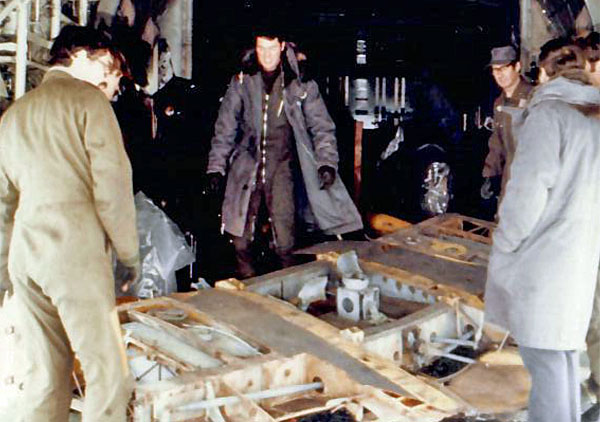
We were tasked as F Troop in November 1977 on a C130 from Lyneham via Gander and Dulles to Calgary. Then returning via CFB Trenton, Hamilton (Ontario) and Gander. The load from Hamilton was an historic aircraft, which my log book records as a Cornell. The photos show it being loaded, with us scratching our heads at one stage as to how we would constrain what looks like the centre wing, without any JATE guidance of course. Anyway, all was well and said aircraft was safely flown back to Lyneham. To be honest, I can’t remember where it went after that.
The other was in February 1978. The weather in Scotland was very bad at the time – heavy snow had closed roads and villages were cut off. To help clear the snow, the UK Government had urgently procured a snowplough from Rolba in Switzerland and we were tasked to pick it up and fly it to Scotland.
My log book shows that it was all done in one day but, for reasons I can’t remember, we landed back at Inverness, then flew to Aberdeen, then flew to Wick (John O’ Groats). Looking at the times on the ground, I think we must have offloaded the snowplough at Aberdeen but there was almost certainly a supplementary load for John O’ Groats, or possibly some urgent relief supplies from Inverness or Aberdeen.
Again it was with F Troop so perhaps Mick Day, Mick Bedford or Geoff Cox can remember more about this load. The photo shows the snowplough being loaded in Zurich, with Dave Whyke (RIP) in the operator’s seat.
My log book shows that it was all done in one day but, for reasons I can’t remember, we landed back at Inverness, then flew to Aberdeen, then flew to Wick (John O’ Groats). Looking at the times on the ground, I think we must have offloaded the snowplough at Aberdeen but there was almost certainly a supplementary load for John O’ Groats, or possibly some urgent relief supplies from Inverness or Aberdeen.
Again it was with F Troop so perhaps Mick Day, Mick Bedford or Geoff Cox can remember more about this load. The photo shows the snowplough being loaded in Zurich, with Dave Whyke (RIP) in the operator’s seat.
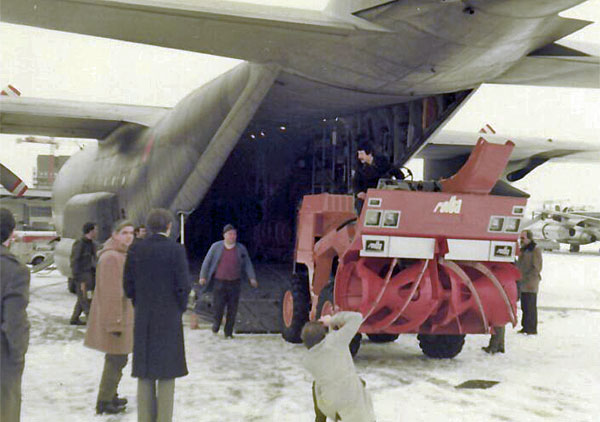
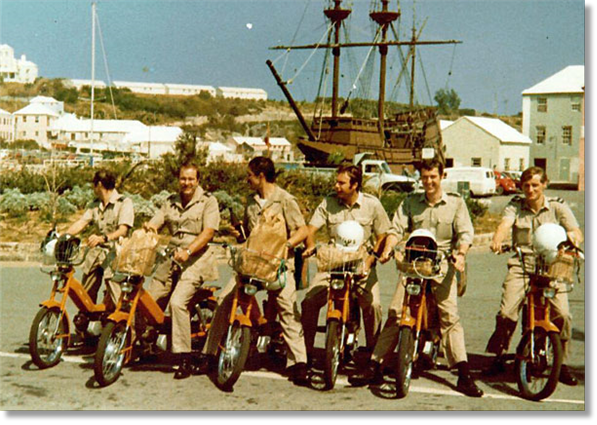
A photograph of F Troop, taken in Bermuda in March 1978 on an exercise recovery task lasting 3 days. I regret I can’t remember the name of the FS facing the other way (Al ??? I think) but the rest of the gang was (L to R) Mick Day, Dave Whyke, Geoff Cox, myself and Mick Bedford.
Regards, Andy
Regards, Andy

Anzac Remembrance Service at Cambridge City Cemetery
April 23, 2022 - A deeply moving ceremony took place this weekend at Cambridge City Cemetery off the Newmarket Road for the men and women from Australia and New Zealand who gave their lives to protect this country during World War 2.
The chairman of the Cambridge Branch of RAFA, David Bailey, explained the historical backdrop to the occasion which took place ahead on Anzac (Australia and New Zealand Army Corps) Day on April 25, “The service personnel are buried there after the Commonwealth War Graves Commission – having been renamed from Imperial War Graves – was established between the wars. During the war a large proportion of the RAF’s Bomber Command crews were piloted by servicemen from Canada, Australia, South Africa and New Zealand, and many of them sadly lost their lives. “There were 50 airfields around Cambridge during the war and 200 airfields in East Anglia. Bourn airfield was one of the biggest, along with Wratting, Wyton, Foxton, Fowlmere, Bottisham – there were one million people serving in RAF by the end of WW2.
“Altogether three are 750 airmen and women buried in the [main] cemetery. They include 250 Australians in the RAF as part of the Royal Australian Air Force, 80 New Zealanders from the Royal New Zealand Air Force, and 89 Canadians from the Royal Canadian Air Force. Many of them came over from the Commonwealth at the start of the war when we were on our own. There are also 180 burials from WW1 in scattered around other parts of the site, of whom 15 are Anzac graves.”
cambridgeindependant.co.uk
The chairman of the Cambridge Branch of RAFA, David Bailey, explained the historical backdrop to the occasion which took place ahead on Anzac (Australia and New Zealand Army Corps) Day on April 25, “The service personnel are buried there after the Commonwealth War Graves Commission – having been renamed from Imperial War Graves – was established between the wars. During the war a large proportion of the RAF’s Bomber Command crews were piloted by servicemen from Canada, Australia, South Africa and New Zealand, and many of them sadly lost their lives. “There were 50 airfields around Cambridge during the war and 200 airfields in East Anglia. Bourn airfield was one of the biggest, along with Wratting, Wyton, Foxton, Fowlmere, Bottisham – there were one million people serving in RAF by the end of WW2.
“Altogether three are 750 airmen and women buried in the [main] cemetery. They include 250 Australians in the RAF as part of the Royal Australian Air Force, 80 New Zealanders from the Royal New Zealand Air Force, and 89 Canadians from the Royal Canadian Air Force. Many of them came over from the Commonwealth at the start of the war when we were on our own. There are also 180 burials from WW1 in scattered around other parts of the site, of whom 15 are Anzac graves.”
cambridgeindependant.co.uk

From: Liam Devlin, Port Talbot, West Glamorgan
Subject: Strange Loads
Hi Tony,
In January 1964, I was on FEAF MAMS in Tawau, Sabah; this was before the formation of Malaysia. President Sukarno of Indonesia didn’t want North Borneo to become part of Malaysia so he sent in his insurgents to hopefully disrupt this process. The MAMS Team were sent in with a Beverley and a Hastings full of Gurkha soldiers to see off the Indonesian insurgents.
Now for the Strange Load. Every afternoon a Whirlwind helicopter brought in the dead Indonesians, but one day the helicopter brought in four live Indonesians who had been captured by the Gurkhas. A Beverley was called in to take them away. The aircraft had been on a re-supply drop so there were no clam shell doors fitted [the back of the aircraft was wide open to the elements]. We put the prisoners face down on the floor and used lashing tape to tie them to the floor through their handcuffs and the aircraft ‘D’ rings. And off they went to Labuan!
Regards
Liam
Subject: Strange Loads
Hi Tony,
In January 1964, I was on FEAF MAMS in Tawau, Sabah; this was before the formation of Malaysia. President Sukarno of Indonesia didn’t want North Borneo to become part of Malaysia so he sent in his insurgents to hopefully disrupt this process. The MAMS Team were sent in with a Beverley and a Hastings full of Gurkha soldiers to see off the Indonesian insurgents.
Now for the Strange Load. Every afternoon a Whirlwind helicopter brought in the dead Indonesians, but one day the helicopter brought in four live Indonesians who had been captured by the Gurkhas. A Beverley was called in to take them away. The aircraft had been on a re-supply drop so there were no clam shell doors fitted [the back of the aircraft was wide open to the elements]. We put the prisoners face down on the floor and used lashing tape to tie them to the floor through their handcuffs and the aircraft ‘D’ rings. And off they went to Labuan!
Regards
Liam


From: Kevin Koslowski Smith, St Neots, Cambs
Subject: Strange Loads
Tony
Lyneham... Heavylift Antonov 124 to be loaded with an "Aardvark" mine clearing machine...
Instructions to pongo driver, DO NOT STEER ON THE RAMP! What does he go and do... He takes out one of the ramp's hydraulic rams!
"Don't worry, two hours for replacement by helicopter" was the loadmasters reply in a thick Russian accent...
Two hours later, a helicopter lands, the hydraulic ram was replaced and the aircraft takes off just a couple of hours late!
No way would we have been able to do that! Don't have any photo's though! If anyone on the team then can provide any, that'd be great!
Kev
Subject: Strange Loads
Tony
Lyneham... Heavylift Antonov 124 to be loaded with an "Aardvark" mine clearing machine...
Instructions to pongo driver, DO NOT STEER ON THE RAMP! What does he go and do... He takes out one of the ramp's hydraulic rams!
"Don't worry, two hours for replacement by helicopter" was the loadmasters reply in a thick Russian accent...
Two hours later, a helicopter lands, the hydraulic ram was replaced and the aircraft takes off just a couple of hours late!
No way would we have been able to do that! Don't have any photo's though! If anyone on the team then can provide any, that'd be great!
Kev
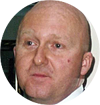

From: Brian Hunt, Brighton, East Sussex
Subject: Strange Loads
AN UNUSUAL EQUINE LOAD
We were at Waddington, having driven there and done some offloads, probably ex-Giant Voice. We were about to leave at about knocking off time and return to Lyneham, when OC Supply cornered us and asked if we could hang around. A DC6 was to make an emergency landing and had a tricky cargo that needed offloading and who better than a MAMS team to do it!
Eventually, a dilapidated DC6 approached the airfield. We could see one engine was u/s and as it did a gentle turn onto finals we could see an engine on the other side was also u/s! It touched down and burst one tyre, with a bang and a cloud of smoke, followed by a bang and a cloud of smoke on the other side! It limped off the runway and stopped on a taxiway.
Subject: Strange Loads
AN UNUSUAL EQUINE LOAD
We were at Waddington, having driven there and done some offloads, probably ex-Giant Voice. We were about to leave at about knocking off time and return to Lyneham, when OC Supply cornered us and asked if we could hang around. A DC6 was to make an emergency landing and had a tricky cargo that needed offloading and who better than a MAMS team to do it!
Eventually, a dilapidated DC6 approached the airfield. We could see one engine was u/s and as it did a gentle turn onto finals we could see an engine on the other side was also u/s! It touched down and burst one tyre, with a bang and a cloud of smoke, followed by a bang and a cloud of smoke on the other side! It limped off the runway and stopped on a taxiway.
The load was 40 old ponies flying from Ireland to Denmark, presumably heading for the glue factory! They were tethered to pieces of 4x2 fixed to the sides of the fuselage, with a bit of straw on the floor! Apart from a halter, there were no restraints!
Then we had the usual wait for customs! At last we were free to unload which was a Heath-Robinson affair. We used a 12000lb FLT with a large slave pallet and two guys, one on each side with a NATO pallet to dissuade the ponies from jumping off! Fortunately none of them jumped off and no one got hurt, but it could have been very different!
We were soon on our way back to Lyneham but Waddington had a headache for several days. The horses had to be quarantined in a segregated field, fed and watered until the aircraft was fixed! The crew reckoned the horses’ urine had got into the electrics controlling the fuel supply which then failed. Presumably they waterproofed the floor for the next leg!
I was never very good at keeping a good record in my log book, so if anyone can add to this story or correct any of my false memories, please do!
(PS. The only other time I went inside a DC6 was at Akrotiri in 1973. It was a Red Cross aircraft evacuating Greek casualties. Unlike the ISCargo aircraft it was immaculate and the inside looked as good as new!)
Then we had the usual wait for customs! At last we were free to unload which was a Heath-Robinson affair. We used a 12000lb FLT with a large slave pallet and two guys, one on each side with a NATO pallet to dissuade the ponies from jumping off! Fortunately none of them jumped off and no one got hurt, but it could have been very different!
We were soon on our way back to Lyneham but Waddington had a headache for several days. The horses had to be quarantined in a segregated field, fed and watered until the aircraft was fixed! The crew reckoned the horses’ urine had got into the electrics controlling the fuel supply which then failed. Presumably they waterproofed the floor for the next leg!
I was never very good at keeping a good record in my log book, so if anyone can add to this story or correct any of my false memories, please do!
(PS. The only other time I went inside a DC6 was at Akrotiri in 1973. It was a Red Cross aircraft evacuating Greek casualties. Unlike the ISCargo aircraft it was immaculate and the inside looked as good as new!)
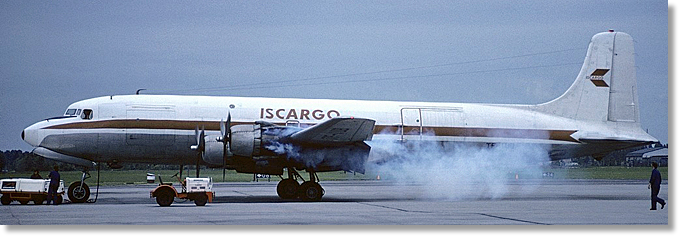


Loadmaster Training for the A400M Atlas
Rheinmetall provides the latest technology rear crew training aids for air transport platforms and is the world market leader providing Load Master Work Station Trainer (LMWST) and Cargo Hold Trainers for transport aircraft.
The LMWST is a real life training platform for the application of theoretical and procedural aspects that cannot be covered to a suitable standard or conclusion during flight training (e.g. aerial delivery and emergency procedures). The instructor is able to create, edit and direct an array of training scenarios and control the entire simulation.
Learn more on the Rheinmetall website: www.rheinmetall-simulation.com
The LMWST is a real life training platform for the application of theoretical and procedural aspects that cannot be covered to a suitable standard or conclusion during flight training (e.g. aerial delivery and emergency procedures). The instructor is able to create, edit and direct an array of training scenarios and control the entire simulation.
Learn more on the Rheinmetall website: www.rheinmetall-simulation.com

From: Andy Spinks, Falmouth, Cornwall
Subject: Re: UKMAMS OBA OBB #033122
Hi Tony,
Another great read with so many great memories re-kindled. Many thanks for all you do to keep us in touch and help us to remember the good times.
Dave Green wondered who had the idea of movers becoming the MAC (Military Aircraft Commander) on the TriStars, before 216 Sqn had ALMs. Well, as SAMO Brize at the time, I initiated it, although my day team at the time (including Tony Davenport, Gordon Thompson and Chris Cahill) were all part of it because I would like to think we were very much one team. But it was quite a complex undertaking and probably bears some explanation.
Initially, the TriStars were bought to be used as tankers. However, there was to be a long wait until they went individually to Marshall Cambridge for conversion, and someone in MOD or possibly Group had the great idea that they should be used for passenger work while still in a 250-seat passenger fit. Initially, the flight deck and cabin crews were all BA; the RAF flight deck crews started to go through the BA training centre but were not yet flying the actual aircraft. And there were no RAF ALMs or stewards on 216 Sqn at the time. Well, there was one ALM (an ex-Britannia and VC10 loadie who name escapes me but his face doesn’t – he was not a great friend to the movers though) to develop the cabin crew recruitment and training.
So we had 6 aircraft (later to be 9 when the ex-Pan Am aircraft arrived), BA flight deck and cabin crews, but no military person to formally be in charge of the MOD asset, complete the load sheets (in BA parlance, despatch the aircraft), and secure the powered lower hold doors. I proposed movements officers/WOs to undertake this dual role until the ALMs were posted in and this was accepted.
So nearly all of the officers on the BZZ Movs Sqn, several UKMAMS team leaders, and some Germany movers were allocated to the task. It all went well, and we had a really enjoyable time flying with BA flight deck and cabin crews (who treated us as one of the crew and were more welcoming than some of the RAF crews). The only downside was that the BA cabin crews were all male because of the limited facilities on Ascension Island. But the GD branch and particularly the ALM fraternity were clearly anxious to revert to normal arrangements and, bit by bit, we were replaced with ALMs coming out of training or re-roling to the TriStar. Prior to this, I had tried to cement us in the role and this went up to Group for a decision - but we lost! However, as an aside, I believed – as I still do - that the core of ALMs on all transport aircraft could have come from the movements trade (as the RCAF) but this never got any traction.
Dave Green mentioned the TriStar MACs in the context of DFs, writing that we were technically pax and therefore entitled to DFs. To be honest, I can’t remember whether we were manifested or on the gen dec in the early days – the good memories were simply going down route with the BA crews (and staying in their hotels - Dakar was a particularly good nightstop). And we became friends with a lot of the BA crews, indeed one of them was a cabin crew supervisor at LHR and invited me up to the BA HQ to look at their operation. But his motive was actually to introduce me to one of his (female) cabin crew colleagues – we were obviously attracted to each other as, 6 months later, we got married and are still happily together some 32 years later!
All the best
Andy
Subject: Re: UKMAMS OBA OBB #033122
Hi Tony,
Another great read with so many great memories re-kindled. Many thanks for all you do to keep us in touch and help us to remember the good times.
Dave Green wondered who had the idea of movers becoming the MAC (Military Aircraft Commander) on the TriStars, before 216 Sqn had ALMs. Well, as SAMO Brize at the time, I initiated it, although my day team at the time (including Tony Davenport, Gordon Thompson and Chris Cahill) were all part of it because I would like to think we were very much one team. But it was quite a complex undertaking and probably bears some explanation.
Initially, the TriStars were bought to be used as tankers. However, there was to be a long wait until they went individually to Marshall Cambridge for conversion, and someone in MOD or possibly Group had the great idea that they should be used for passenger work while still in a 250-seat passenger fit. Initially, the flight deck and cabin crews were all BA; the RAF flight deck crews started to go through the BA training centre but were not yet flying the actual aircraft. And there were no RAF ALMs or stewards on 216 Sqn at the time. Well, there was one ALM (an ex-Britannia and VC10 loadie who name escapes me but his face doesn’t – he was not a great friend to the movers though) to develop the cabin crew recruitment and training.
So we had 6 aircraft (later to be 9 when the ex-Pan Am aircraft arrived), BA flight deck and cabin crews, but no military person to formally be in charge of the MOD asset, complete the load sheets (in BA parlance, despatch the aircraft), and secure the powered lower hold doors. I proposed movements officers/WOs to undertake this dual role until the ALMs were posted in and this was accepted.
So nearly all of the officers on the BZZ Movs Sqn, several UKMAMS team leaders, and some Germany movers were allocated to the task. It all went well, and we had a really enjoyable time flying with BA flight deck and cabin crews (who treated us as one of the crew and were more welcoming than some of the RAF crews). The only downside was that the BA cabin crews were all male because of the limited facilities on Ascension Island. But the GD branch and particularly the ALM fraternity were clearly anxious to revert to normal arrangements and, bit by bit, we were replaced with ALMs coming out of training or re-roling to the TriStar. Prior to this, I had tried to cement us in the role and this went up to Group for a decision - but we lost! However, as an aside, I believed – as I still do - that the core of ALMs on all transport aircraft could have come from the movements trade (as the RCAF) but this never got any traction.
Dave Green mentioned the TriStar MACs in the context of DFs, writing that we were technically pax and therefore entitled to DFs. To be honest, I can’t remember whether we were manifested or on the gen dec in the early days – the good memories were simply going down route with the BA crews (and staying in their hotels - Dakar was a particularly good nightstop). And we became friends with a lot of the BA crews, indeed one of them was a cabin crew supervisor at LHR and invited me up to the BA HQ to look at their operation. But his motive was actually to introduce me to one of his (female) cabin crew colleagues – we were obviously attracted to each other as, 6 months later, we got married and are still happily together some 32 years later!
All the best
Andy


From: Ian Place, Meanwood, West Yorks
Subject: Strange Loads
Tony,
Talking about special loads, on 22nd October 1975, Hotel Team UK MAMS were tasked with taking a boxed frigate engine for HMS Nubian which was marooned in the waters of Trinidad and Tobago. Even though we departed from Brize, the base movers left us to load it because I can remember having to use a ladder to chain lash this huge box to the floor.
Subject: Strange Loads
Tony,
Talking about special loads, on 22nd October 1975, Hotel Team UK MAMS were tasked with taking a boxed frigate engine for HMS Nubian which was marooned in the waters of Trinidad and Tobago. Even though we departed from Brize, the base movers left us to load it because I can remember having to use a ladder to chain lash this huge box to the floor.

We departed in Belfast XR364, night stopping in Lajes, Azores, enroute. Command Ops wanted us to fly from Lajes to Piarco, Trinidad direct, but our Captain, Flt lt Bevan, said he wouldn't have sufficient fuel and we would land 1,000 miles short of the main runway so they told us to get airborne and then they would inform us of our revised routing.
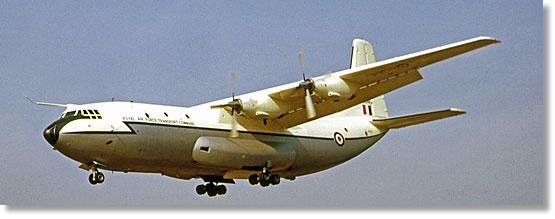
8 hours 35 mins later we landed in Bermuda. After a night in the Castle Harbour Hotel, we set off over the triangle to Trinidad. On arrival, the Navy sent us a local truck which ended up with flat leaf springs. This poor little truck inched away from the aircraft carrying the huge load. Job Done. Oh, and the roads in Trinidad were rutted so badly we prayed that the engine got there in one piece!
Ian
Ian

From: Stephen Davey, Tadcaster, North Yorks
Subject: Strange Loads
Tony,
I don't know about "strange" loads but I did experience some unusual ones in my short time on Movements. A Lightning F6 in a crate on a Belfast returning from Singapore, just like a giant Airfix kit, the aircraft was a 74 Sqn F6 I think.
Another one that comes to mind was a Shorts Stranraer flying boat coming back from Canada, again on a Belfast, I could be mistaken but this particular aircraft could now be in the RAF Museum at Hendon.
I also remember loading Sea King helicopters for the Indian Navy onto Belfasts. I acknowledge that these are not what you would call "strange" loads, but were nevertheless challenging at the time. Happy days eh?
Regards,
Steve Davey
Subject: Strange Loads
Tony,
I don't know about "strange" loads but I did experience some unusual ones in my short time on Movements. A Lightning F6 in a crate on a Belfast returning from Singapore, just like a giant Airfix kit, the aircraft was a 74 Sqn F6 I think.
Another one that comes to mind was a Shorts Stranraer flying boat coming back from Canada, again on a Belfast, I could be mistaken but this particular aircraft could now be in the RAF Museum at Hendon.
I also remember loading Sea King helicopters for the Indian Navy onto Belfasts. I acknowledge that these are not what you would call "strange" loads, but were nevertheless challenging at the time. Happy days eh?
Regards,
Steve Davey


From: Andy Kay, Bowling Green, KY
Subject: Strange Loads
Hi Tony,
Plenty of weird loads when I was in Oman with SOAF (now known as RAFO) back in the days when it was a little less formal and more like the wild west at times. A fairly normal rotation was Sultan Qaboos's very valuable racing camels which used to move between Muscat and Salalah and back every year when the royal household went down south to escape the summer heat. The camels had their own boxes which went on a pallet and were shipped down in a C130. They were very bad tempered animals, and we didn't get too close or they would spit or try and bite us.
Even better was at the end of Ramadan, the Sultan would have live goats sent out to villages in the interior of Oman as a gift to the people so they could be freshly slaughtered as part of the Eid celebrations. They would just be loaded into Skyvans and a cargo net thrown over them for the short(ish) flights into the rough strips they used. One year we had a load of goats turn up at the Seeb air cargo shed in the back of a dump truck, just a load of loose goats. The driver proceeded to lift the dump truck bed and about 50 or so goats slid out through the swing back like they were a pile of dirt. Great hilarity ensued as my movements staff tried to chase down and capture the goats before they ran onto the airfield proper, luckily most of them were hobbled so they didn't get far. We got all of them, well nearly all of them.
When the shift ended my Omani airmen and civilian laborers were getting ready to head out for their own Eid festivities when I heard a bleating noise from the back seat of one of their cars. The young corporal looked at me and just shrugged and said, "A gift from the Sultan". I didn't argue, it was his country and his boss.
Stay safe!
Andy Kay
Subject: Strange Loads
Hi Tony,
Plenty of weird loads when I was in Oman with SOAF (now known as RAFO) back in the days when it was a little less formal and more like the wild west at times. A fairly normal rotation was Sultan Qaboos's very valuable racing camels which used to move between Muscat and Salalah and back every year when the royal household went down south to escape the summer heat. The camels had their own boxes which went on a pallet and were shipped down in a C130. They were very bad tempered animals, and we didn't get too close or they would spit or try and bite us.
Even better was at the end of Ramadan, the Sultan would have live goats sent out to villages in the interior of Oman as a gift to the people so they could be freshly slaughtered as part of the Eid celebrations. They would just be loaded into Skyvans and a cargo net thrown over them for the short(ish) flights into the rough strips they used. One year we had a load of goats turn up at the Seeb air cargo shed in the back of a dump truck, just a load of loose goats. The driver proceeded to lift the dump truck bed and about 50 or so goats slid out through the swing back like they were a pile of dirt. Great hilarity ensued as my movements staff tried to chase down and capture the goats before they ran onto the airfield proper, luckily most of them were hobbled so they didn't get far. We got all of them, well nearly all of them.
When the shift ended my Omani airmen and civilian laborers were getting ready to head out for their own Eid festivities when I heard a bleating noise from the back seat of one of their cars. The young corporal looked at me and just shrugged and said, "A gift from the Sultan". I didn't argue, it was his country and his boss.
Stay safe!
Andy Kay


Royal Air Force Air Mobility
The Air Mobility Force, based RAF Brize Norton consists of strategic and tactical transport and air to air refuelling aircraft. The Force has worked around the clock to deliver military and humanitarian aid as part of the UK’s efforts in supporting Ukraine.
The Voyager air-to-air refueller has supported UK and NATO jets, helping to extend their endurance and range.
The Voyager air-to-air refueller has supported UK and NATO jets, helping to extend their endurance and range.

From: Harold Jones, Neston, Cheshire
Subject: Strange Loads
A Car, a Dog and a Budgie
“I’ve just talked Ops into giving us a great little jolly”, said the Boss, Dave (Rate 1) Edwards to his assembled team.
“Oh yeah?” said ‘J’ team “tell us about it.”
“A nice little jolly” he said, "an Argosy across to Oslo, the capitol of Norway (educational as well!) taking the new NATO boss’s car, a dog and a budgie and bringing back the old NATO boss, sledge, reindeer and artic skua (stercorarius pomarinus) if you happen to be a member of the R.S.P.C.B."
We got to RAF Leeming and surveyed the load. The car was a rather large Mercedes, the budgie was a parrot and the dog was a Labrador!
A Mercedes has a low ground clearance whilst the ramps of an Argosy required a considerable ground clearance. As members of the Generals staff were interested spectators, we could not just close our ears to the screams of tortured metal and the plaintive bleats of the driver’s tea caddy, but had to do it without damage to car or aircraft. It was whilst scouting round looking for dunnage that I was accosted by a chap driving a huge pantechnican (Beverley without wings to the uninitiated) “Ere mate, is you in charge?” he arsked (reminiscent of Peter Sellers in the Goons) “As I 'ave a bit of stuff in me motor to go to Hoslo and I was told to bring it 'ere.”
Subject: Strange Loads
A Car, a Dog and a Budgie
“I’ve just talked Ops into giving us a great little jolly”, said the Boss, Dave (Rate 1) Edwards to his assembled team.
“Oh yeah?” said ‘J’ team “tell us about it.”
“A nice little jolly” he said, "an Argosy across to Oslo, the capitol of Norway (educational as well!) taking the new NATO boss’s car, a dog and a budgie and bringing back the old NATO boss, sledge, reindeer and artic skua (stercorarius pomarinus) if you happen to be a member of the R.S.P.C.B."
We got to RAF Leeming and surveyed the load. The car was a rather large Mercedes, the budgie was a parrot and the dog was a Labrador!
A Mercedes has a low ground clearance whilst the ramps of an Argosy required a considerable ground clearance. As members of the Generals staff were interested spectators, we could not just close our ears to the screams of tortured metal and the plaintive bleats of the driver’s tea caddy, but had to do it without damage to car or aircraft. It was whilst scouting round looking for dunnage that I was accosted by a chap driving a huge pantechnican (Beverley without wings to the uninitiated) “Ere mate, is you in charge?” he arsked (reminiscent of Peter Sellers in the Goons) “As I 'ave a bit of stuff in me motor to go to Hoslo and I was told to bring it 'ere.”
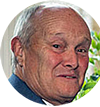
Three tons of her Ladyship's hats was not in the original script but ours not to reason why and hopefully not to do or ***. We finally got it all loaded; hats, zoo, car show room, sports store Marks and Sparks and assorted VIPs, just like a car boot sale. Still, we loaded everything that could be loaded, rigged up a VIP area for the General and away we went.
We landed, waited whilst the pongoes played pongoes to music and offloaded the lot. The return load was very ordinary, an old Ford together with some bent skis and a few chaps in brown uniforms.
And so ended another job well done.
Harold Jones
UKMAMS 1969 - 1972
We landed, waited whilst the pongoes played pongoes to music and offloaded the lot. The return load was very ordinary, an old Ford together with some bent skis and a few chaps in brown uniforms.
And so ended another job well done.
Harold Jones
UKMAMS 1969 - 1972
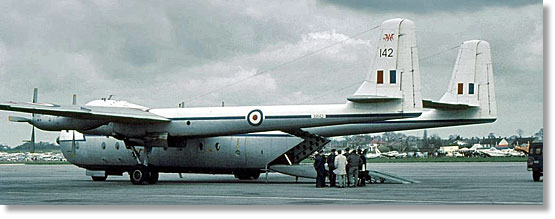

New members who have joined us recently:
Welcome to the OBA!
Bill Hall, Canberra, ACT
Terry Jackson, St. Albans, Herts



From: Terry Jackson, St Albans, Herts
Subject: Operation Hillclimb
Dear Tony,
I was trawling through the internet and came across the MAMS site. I was shocked to read of Bill Girdwood’s death. I served with Bill (Flt Lt) on Operation Hillclimb in Penang. I was the seconded Sergeant supplier. I later did a movements course at Abingdon and did two tours as a ‘mover’. Air Cargo in Singapore 1971 during the withdrawl and then JSATC Hendon as a shift leader.
My time spent with Bill has many special memories especially moving a Radome up Penang Hill on the train and taking it off to go through the tunnel. A bunch of guys thinking on their feet.
After work one day I was taking Bill back to his accommodation in George Town, I think it was the Eastern and Oriental Hotel. We were in a ‘3 tonner’ and I was driving. As we approached the entrance he reminded me very quietly about the ‘lid’ on the vehicle. I was within 50 yards of taking it off at the entrance to the hotel!
I returned to the UK from Changi in October 1971 to work at JSATC on promotion to Flight Sergeant. How Bill knew I was there I do not know but he phoned me to offer congratulations on my promotion.
Special memories of working with a very nice guy.
Kind Regards
Terry Jackson
[Before his passing, Bill Girdwood was a very active member of the OBA and one of the articles he wrote was all about Operation Hillclimb in Penang: http://ukmamsoba.org/hillclimb.html ]
Subject: Operation Hillclimb
Dear Tony,
I was trawling through the internet and came across the MAMS site. I was shocked to read of Bill Girdwood’s death. I served with Bill (Flt Lt) on Operation Hillclimb in Penang. I was the seconded Sergeant supplier. I later did a movements course at Abingdon and did two tours as a ‘mover’. Air Cargo in Singapore 1971 during the withdrawl and then JSATC Hendon as a shift leader.
My time spent with Bill has many special memories especially moving a Radome up Penang Hill on the train and taking it off to go through the tunnel. A bunch of guys thinking on their feet.
After work one day I was taking Bill back to his accommodation in George Town, I think it was the Eastern and Oriental Hotel. We were in a ‘3 tonner’ and I was driving. As we approached the entrance he reminded me very quietly about the ‘lid’ on the vehicle. I was within 50 yards of taking it off at the entrance to the hotel!
I returned to the UK from Changi in October 1971 to work at JSATC on promotion to Flight Sergeant. How Bill knew I was there I do not know but he phoned me to offer congratulations on my promotion.
Special memories of working with a very nice guy.
Kind Regards
Terry Jackson
[Before his passing, Bill Girdwood was a very active member of the OBA and one of the articles he wrote was all about Operation Hillclimb in Penang: http://ukmamsoba.org/hillclimb.html ]

From: Gerry Davis, Bedminster, Somerset
Subject: Thank you letter to the C.Oof the Army D’Aosta Barracks Benghazi
Subject: Thank you letter to the C.Oof the Army D’Aosta Barracks Benghazi

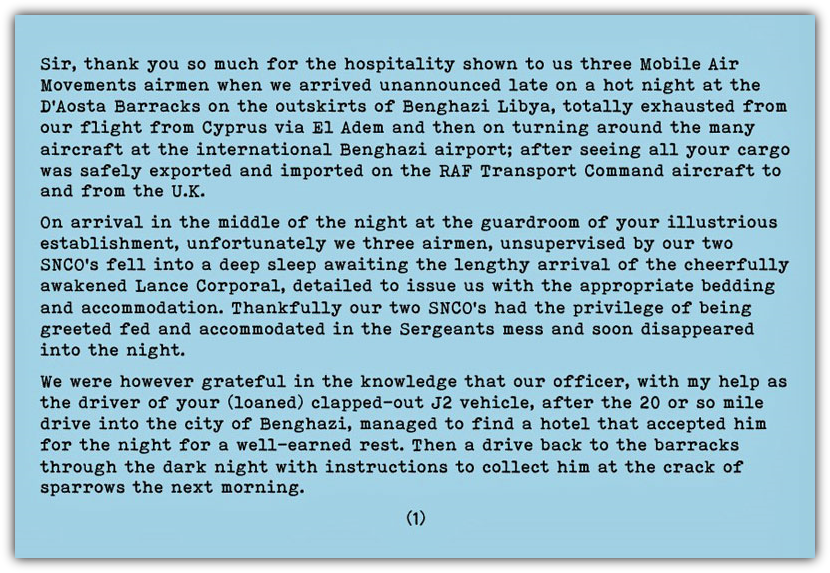
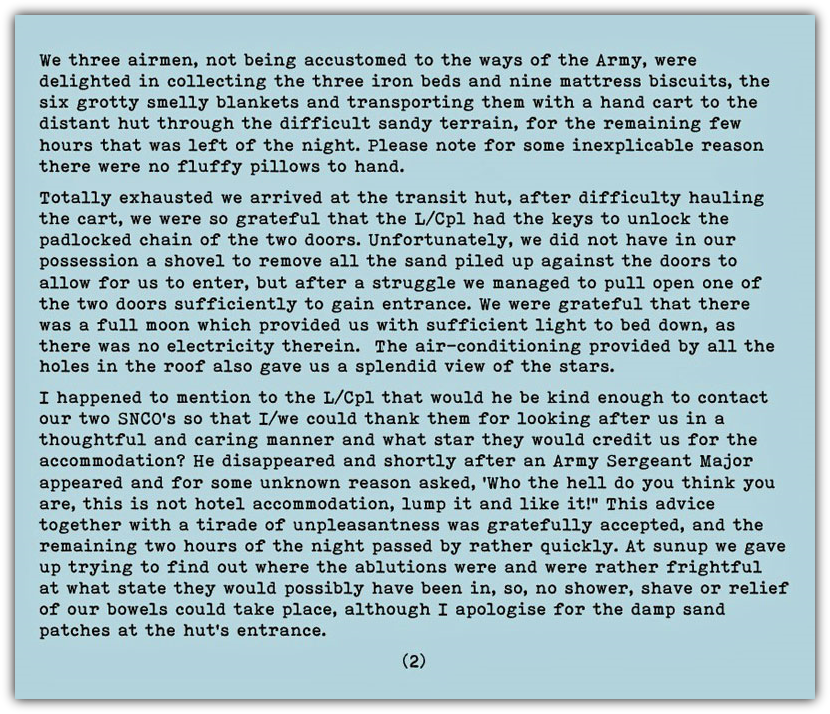
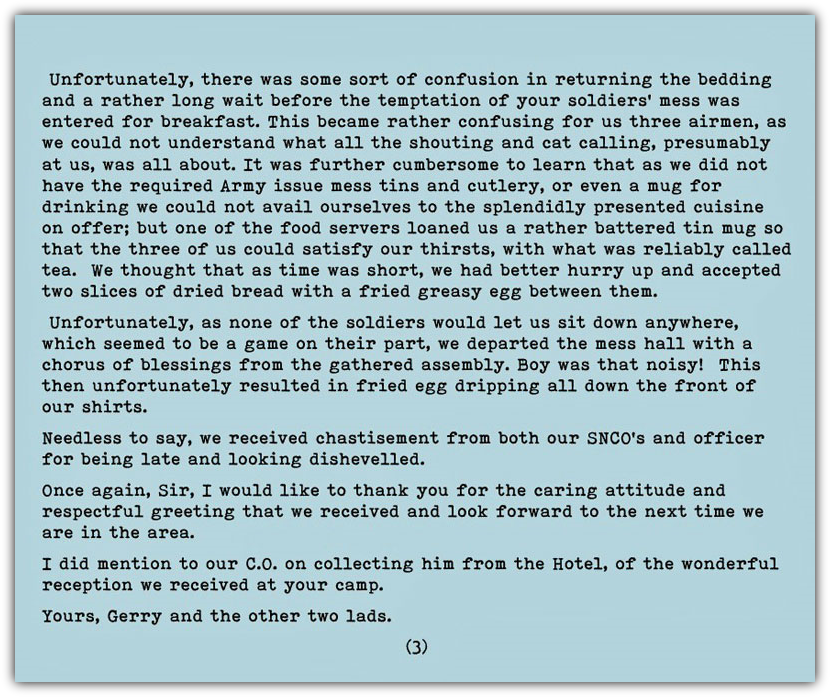

Australia sends six 155mm howitzers and ammo to Ukraine
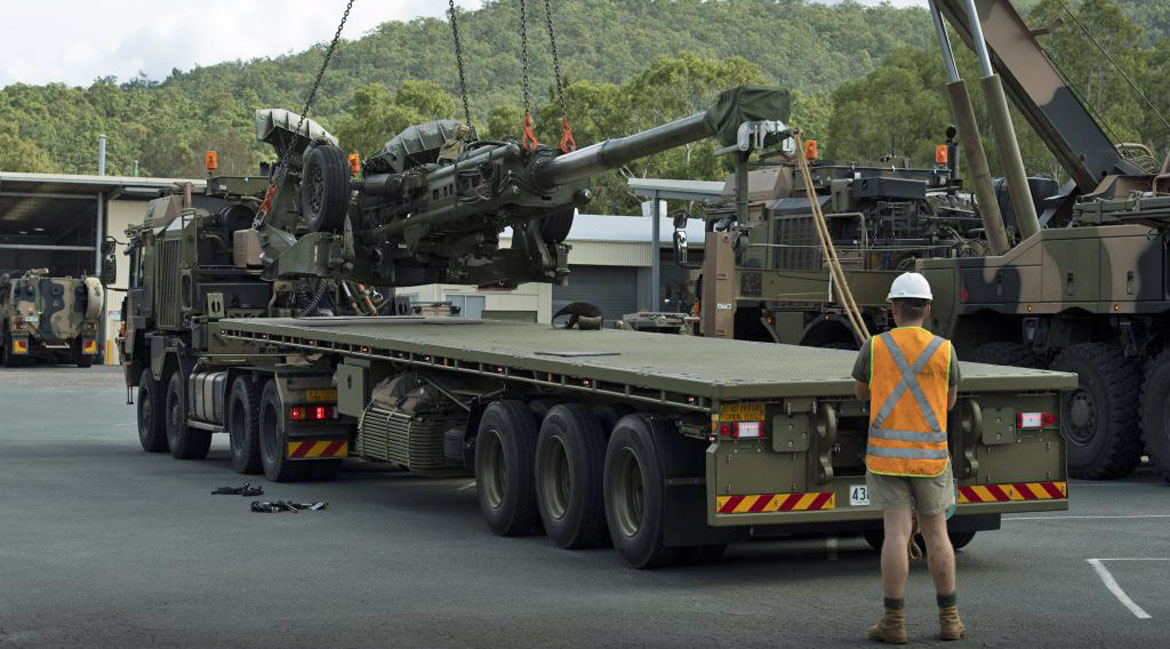
RAAF Air Movements Operators from No. 23 Squadron load M777 155mm lightweight towed howitzers bound for Ukraine onto a C-17A Globemaster III at RAAF Base Amberley in Queensland.
contactairlandandsea.com
contactairlandandsea.com

From: Mark Brierley, York
Subject: Strange Loads
Hi Tony,
Many thanks for your calling note for a few words on strange loads to be published in the next edition of your excellent newsletter.
Two items sprang to mind:
November 1983. I’d just completed the Officers’ Movements Course at the "skule" and was detached to Ascension Island as DAMO B for six months. I met my wife (Jane) there, but that’s another story. At that time, the airbridge schedule between the UK and the Falkland Islands was a VC10 from Brize Norton to ASI every day and five Hercules flights a week from ASI to Port Stanley, which took 13 hours. Three of these Herc flights were freighters and two were PCF. Most flights at the time were carrying numerous metal blocks about two feet square as freight. On first sight, these blocks looked like huge tank track links, but on asking the question, I was told they were the internal parts of a rock crushing machine that was working 24/7 at the Mount Pleasant site crushing rock (obviously enough) to help build the new runway and the support buildings that would become MPA. Whilst the two resupply ships were also carrying these parts down to the Falkland Islands, the machine was wearing them out so quickly that additional blocks had to be air freighted down South. If memory serves, each Hercules flight was carrying at least a pallet of these blocks, but as you can imagine, it didn’t take many of these very heavy items to reach the pallet weight limit.
March 2002. I was CO of Forward Mounting Base (South) located at Karachi International Airport: a Mover as Detachment Commander of about four C130s. At that time, we were operating at least one C130 a night (initially RAF, but later Belgian, Greek, Portuguese, Romanian and Turkish C130s) to Kabul and then Bagram and return every night. The loads contained items that the Army “Shopping Team” had bought locally in Karachi because there was little or nothing available to buy locally in Kabul. Two strange items spring to mind that were regulars on the cargo manifests. One was pallets and pallets of Nestle water in 1.5 litre plastic bottles and the other was rolls and rolls of barbed wire. After a while the amounts of bottled water decreased because the Royal Engineers had sunk a borehole at Bagram to supply the whole camp with fresh drinking water, but it was still a regular item of freight during my detachment to Pakistan. It must have been the most expensive water on the planet if you take the freight cost into account! Oh, I must also mention the UK MAMS detachment doing a roaring trade with their counterparts at Bagram in sending them Karachi produced DVDs of the latest blockbuster films. Again though, that’s another story.
Best wishes,
Mark
Subject: Strange Loads
Hi Tony,
Many thanks for your calling note for a few words on strange loads to be published in the next edition of your excellent newsletter.
Two items sprang to mind:
November 1983. I’d just completed the Officers’ Movements Course at the "skule" and was detached to Ascension Island as DAMO B for six months. I met my wife (Jane) there, but that’s another story. At that time, the airbridge schedule between the UK and the Falkland Islands was a VC10 from Brize Norton to ASI every day and five Hercules flights a week from ASI to Port Stanley, which took 13 hours. Three of these Herc flights were freighters and two were PCF. Most flights at the time were carrying numerous metal blocks about two feet square as freight. On first sight, these blocks looked like huge tank track links, but on asking the question, I was told they were the internal parts of a rock crushing machine that was working 24/7 at the Mount Pleasant site crushing rock (obviously enough) to help build the new runway and the support buildings that would become MPA. Whilst the two resupply ships were also carrying these parts down to the Falkland Islands, the machine was wearing them out so quickly that additional blocks had to be air freighted down South. If memory serves, each Hercules flight was carrying at least a pallet of these blocks, but as you can imagine, it didn’t take many of these very heavy items to reach the pallet weight limit.
March 2002. I was CO of Forward Mounting Base (South) located at Karachi International Airport: a Mover as Detachment Commander of about four C130s. At that time, we were operating at least one C130 a night (initially RAF, but later Belgian, Greek, Portuguese, Romanian and Turkish C130s) to Kabul and then Bagram and return every night. The loads contained items that the Army “Shopping Team” had bought locally in Karachi because there was little or nothing available to buy locally in Kabul. Two strange items spring to mind that were regulars on the cargo manifests. One was pallets and pallets of Nestle water in 1.5 litre plastic bottles and the other was rolls and rolls of barbed wire. After a while the amounts of bottled water decreased because the Royal Engineers had sunk a borehole at Bagram to supply the whole camp with fresh drinking water, but it was still a regular item of freight during my detachment to Pakistan. It must have been the most expensive water on the planet if you take the freight cost into account! Oh, I must also mention the UK MAMS detachment doing a roaring trade with their counterparts at Bagram in sending them Karachi produced DVDs of the latest blockbuster films. Again though, that’s another story.
Best wishes,
Mark

From: Ian Berry, Eastleaze, Swindon, Wilts
Subject: The International Fincastle Competition
Hi Tony,
Subject: The International Fincastle Competition
Hi Tony,
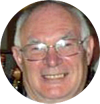
The International Fincastle Competition
The International Fincastle Competition is a contest of skills between the air forces of the United Kingdom, Australia, Canada and New Zealand. During the competition, crews compete in anti-submarine warfare, anti-surface warfare, and intelligence and surveillance gathering.
In November 1973 my UK MAMS team was tasked with delivering a complete set of rapier missile launchers and ancillary equipment from UK to Woomera, South Australia, for trials. This would be accomplished utilising a Belfast C1 Freighter from 53 Sqn and based at RAF Brize Norton. We were also tasked to land at RAF Luqa, Malta and collect all the ground equipment and spares required to support a Nimrod MR1. This aircraft would be from 203 Sqn and was the RAF participant on the soon to start Fincastle Trophy Competition.
In November 1973 my UK MAMS team was tasked with delivering a complete set of rapier missile launchers and ancillary equipment from UK to Woomera, South Australia, for trials. This would be accomplished utilising a Belfast C1 Freighter from 53 Sqn and based at RAF Brize Norton. We were also tasked to land at RAF Luqa, Malta and collect all the ground equipment and spares required to support a Nimrod MR1. This aircraft would be from 203 Sqn and was the RAF participant on the soon to start Fincastle Trophy Competition.

Flight line of 203 Squadron Nimrod MR1 aircraft at RAF Luqa - Fincastle participant XV250 is third from left
The Competition was to be hosted this year by the RAAF and the base chosen was Edinburgh Field, near Adelaide in South Australia. The RAAF, along with the RNZAF and RCAF all operated P3C Orion aircraft. The 203 Sqn support personnel were already being flown ahead of us on a Britannia aircraft. The participating Nimrod MR1, XV250, would leave after us but arrive at a similar time.
We departed Brize on the 18th November on board Belfast XR365 and were due to stay with this aircraft round trip. The aircraft was at that time the largest in the fleet and could carry many outsize loads. It was though, underpowered, using four Rolls Royce Tyne engines.
The same engines were fitted to the CL44 and the twin engine C160 Transall. We loved flying in the thing though as it usually guaranteed a ‘night stop’ somewhere en route. We also affectionately called it the ‘Belslow’. The centre portion of the aircraft was already loaded with the Rapier equipment, courtesy of Air Movements, Brize. This was also the freight position required so that the aircraft ‘trimmed’ correctly. For the whole trip we would be ensconced on the Stub Deck, an extension fitted above the freight deck and level with the flight deck. It was also fitted with 18 seats (6 triples). Such a wonderful aircraft, it even had a flush toilet.
On arrival in Malta the loading was quickly started as we still had to head on to Cyprus to stay the night. The equipment was checked for ‘air preparation’ and manifested too. The wheeled equipment was winched onto the rear of the aircraft. The aircraft winch itself could only be anchored at the front of the freight bay dictated by power cable length! So ancillaries called ‘pulleys and snatch blocks’ were used to route the winch cable around the load that was in the way. It worked as advertised. To load the forward part of the aircraft we opened the large freight door located forward on the port side. In all my time involved with the Belfast this was only one of two occasions when I actually used this access. My team split into two pairs of three, half working at the front and half at the rear. The combination worked well.
We departed Brize on the 18th November on board Belfast XR365 and were due to stay with this aircraft round trip. The aircraft was at that time the largest in the fleet and could carry many outsize loads. It was though, underpowered, using four Rolls Royce Tyne engines.
The same engines were fitted to the CL44 and the twin engine C160 Transall. We loved flying in the thing though as it usually guaranteed a ‘night stop’ somewhere en route. We also affectionately called it the ‘Belslow’. The centre portion of the aircraft was already loaded with the Rapier equipment, courtesy of Air Movements, Brize. This was also the freight position required so that the aircraft ‘trimmed’ correctly. For the whole trip we would be ensconced on the Stub Deck, an extension fitted above the freight deck and level with the flight deck. It was also fitted with 18 seats (6 triples). Such a wonderful aircraft, it even had a flush toilet.
On arrival in Malta the loading was quickly started as we still had to head on to Cyprus to stay the night. The equipment was checked for ‘air preparation’ and manifested too. The wheeled equipment was winched onto the rear of the aircraft. The aircraft winch itself could only be anchored at the front of the freight bay dictated by power cable length! So ancillaries called ‘pulleys and snatch blocks’ were used to route the winch cable around the load that was in the way. It worked as advertised. To load the forward part of the aircraft we opened the large freight door located forward on the port side. In all my time involved with the Belfast this was only one of two occasions when I actually used this access. My team split into two pairs of three, half working at the front and half at the rear. The combination worked well.

Image of forward freight door in use on a Belfast at RAF Brize Norton
From my log book, we were on the ground for exactly two hours before taking off again, fully loaded, for RAF Akrotiri in Cyprus. Our work was done for the next few days until we reached Woomera. Of course we ‘pitched in’ where we could with the operating crew and ground engineer. On such a long task it also gave us all the opportunity to ‘bond’ more! From Cyprus we flew on to RAF Masirah, an island staging post off South Oman. This also entailed sampling a few beers in ‘The Crazy Horse’ Club. The following day it was an early start to head for RAF Gan, another staging post on Addu Atoll in the Maldives. The place really was ‘Heaven on Earth’ but the 650 strong personnel, all male, serving 12 months unaccompanied, didn’t think so! There was one female amongst them, a 60 year old WRVS woman who ran the Malcolm Club.
After spending a night in ‘The Marine Bar’ and getting not that much sleep it was back on board ‘Hector’ (XR365) for our next leg to RAF Tengah, Singapore. I always remember this specific leg of the flight as I sampled for the first time a famous ‘Gan Curry’ as my in-flight lunch. I sat on the flight deck for the approach and landing at Tengah as I had never been to Singapore before. On landing, not far from the side of the runway were the hulks of several Single Pioneer aircraft, rotting away. The only RAF aircraft left operating there at this time were the Wessex HC2 helicopters of 103 Sqn. I found the whole place exciting and alive. Once the aircraft was ‘put to bed’ we all travelled into the city where we were accommodated in the Equatorial Hotel. For most of the rest of my team this was ‘old hat’ as the same hotel was used regularly. I was taken under the wing of my team Sergeant, Ross, who had done a recent tour in Singapore. Later that morning he took me out and to a place called ‘Change Alley’. This was a shoppers’ paradise as all kinds of luxury goods were on sale at duty free prices. Later that afternoon he was met by an old friend of his who now lived near the old RAF base at Seletar which had closed down some two years before. All these new sights and sounds were just totally amazing to me.
Back at the hotel the next morning I was amazed to see another of our UK MAMS teams already in the restaurant. They too were on a Belfast freighter and were carrying two Scorpion light tanks which they were taking around Indonesia. This task was an MoD Sales Charter. It was obviously a success as later the Indonesians bought 90 units. We then headed back to Tengah for our next leg to Darwin, Northern Territory, Australia. After a seven hour flight we arrived at Darwin. We taxied to the RAAF side of the base. My first introduction to Australia, and repeated several times since, was the immediate rude appearance of a Customs man who fired off several insecticide containers. This was after we had already used our own and provided the empties as proof. Once we were eventually allowed off, the RAAF ground crew were very friendly. I also remember they all drove drab olive VW Minibuses which all sported highly polished hub caps. Darwin was also an amazing place and very tropical. All the houses seemed to be built on concrete stilts and this was due to flooding when the typhoons hit. Just a year later, Darwin was struck by Cyclone Tracy and this destroyed 80% of the houses. As it was, whilst we were there it did have the feel of a ‘Frontier’ town.
After spending a night in ‘The Marine Bar’ and getting not that much sleep it was back on board ‘Hector’ (XR365) for our next leg to RAF Tengah, Singapore. I always remember this specific leg of the flight as I sampled for the first time a famous ‘Gan Curry’ as my in-flight lunch. I sat on the flight deck for the approach and landing at Tengah as I had never been to Singapore before. On landing, not far from the side of the runway were the hulks of several Single Pioneer aircraft, rotting away. The only RAF aircraft left operating there at this time were the Wessex HC2 helicopters of 103 Sqn. I found the whole place exciting and alive. Once the aircraft was ‘put to bed’ we all travelled into the city where we were accommodated in the Equatorial Hotel. For most of the rest of my team this was ‘old hat’ as the same hotel was used regularly. I was taken under the wing of my team Sergeant, Ross, who had done a recent tour in Singapore. Later that morning he took me out and to a place called ‘Change Alley’. This was a shoppers’ paradise as all kinds of luxury goods were on sale at duty free prices. Later that afternoon he was met by an old friend of his who now lived near the old RAF base at Seletar which had closed down some two years before. All these new sights and sounds were just totally amazing to me.
Back at the hotel the next morning I was amazed to see another of our UK MAMS teams already in the restaurant. They too were on a Belfast freighter and were carrying two Scorpion light tanks which they were taking around Indonesia. This task was an MoD Sales Charter. It was obviously a success as later the Indonesians bought 90 units. We then headed back to Tengah for our next leg to Darwin, Northern Territory, Australia. After a seven hour flight we arrived at Darwin. We taxied to the RAAF side of the base. My first introduction to Australia, and repeated several times since, was the immediate rude appearance of a Customs man who fired off several insecticide containers. This was after we had already used our own and provided the empties as proof. Once we were eventually allowed off, the RAAF ground crew were very friendly. I also remember they all drove drab olive VW Minibuses which all sported highly polished hub caps. Darwin was also an amazing place and very tropical. All the houses seemed to be built on concrete stilts and this was due to flooding when the typhoons hit. Just a year later, Darwin was struck by Cyclone Tracy and this destroyed 80% of the houses. As it was, whilst we were there it did have the feel of a ‘Frontier’ town.
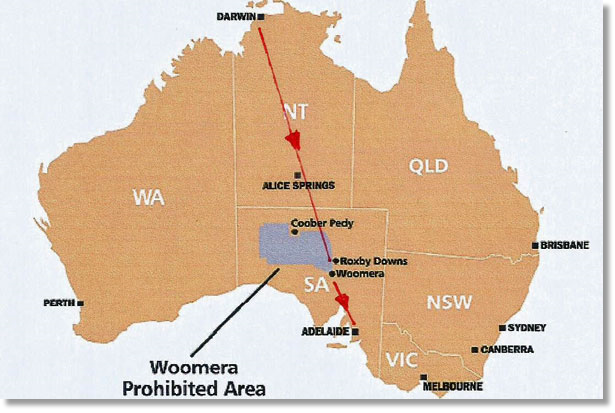
Darwin - GAFA - Woomera - Edinburgh Field
On arrival at Edinburgh Field, we set about unloading the Nimrod support equipment with the grateful assistance of the ‘Aussie Movers’.
There was also a presence from some of the ground crew from 203 Sqn as both the Britannia and the Nimrod itself had arrived before us. We were also informed that there would be a ‘backload’ for UK but this would not be available until four hours before our planned departure.
This was in two days time (Sunday) as we had a mandatory long stop over. The operating crew had already left the airfield well before us but eventually we all met up in the hotel, located in the outskirts of Elizabeth, Northern Adelaide.
To this day I remember the hotel, which was named The Kariwara. The owner was a divorced lady and met us all with a beer. During the introductions and explanation of rules she explained that she was going away for the weekend and that we had free run of the kitchen and could help ourselves!
There was also a presence from some of the ground crew from 203 Sqn as both the Britannia and the Nimrod itself had arrived before us. We were also informed that there would be a ‘backload’ for UK but this would not be available until four hours before our planned departure.
This was in two days time (Sunday) as we had a mandatory long stop over. The operating crew had already left the airfield well before us but eventually we all met up in the hotel, located in the outskirts of Elizabeth, Northern Adelaide.
To this day I remember the hotel, which was named The Kariwara. The owner was a divorced lady and met us all with a beer. During the introductions and explanation of rules she explained that she was going away for the weekend and that we had free run of the kitchen and could help ourselves!
Yet again the next morning we climbed back on board Hector, the aircraft was behaving extremely well with no real snags. We were advised that today the leg to Woomera would take 4hrs 20mins and we would be flying over the GAFA (Great Australian Fanny Adams!). On arrival at RAAF Woomera we began to offload the rapier equipment. We now paid the price for the way it had been loaded in the UK and some ‘double handling’ was needed to get the kit off and then rearrange the remaining load to keep the aircraft in trim. In just over two hours we were on our way again on the final leg down to RAAF Edinburgh Field, just outside of Adelaide.
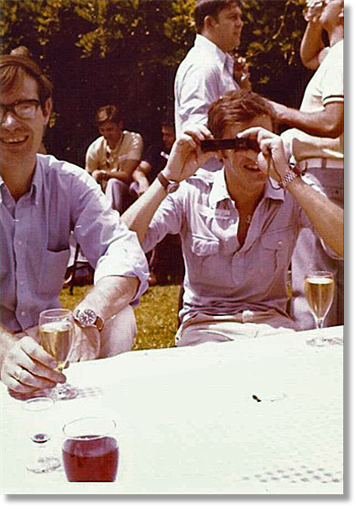
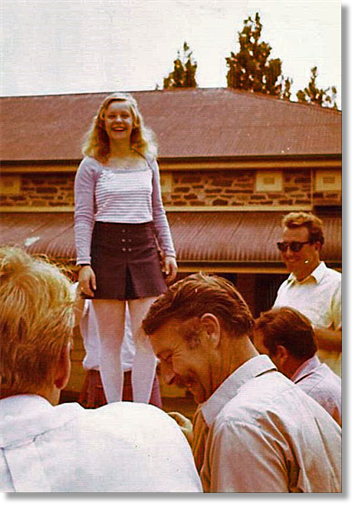
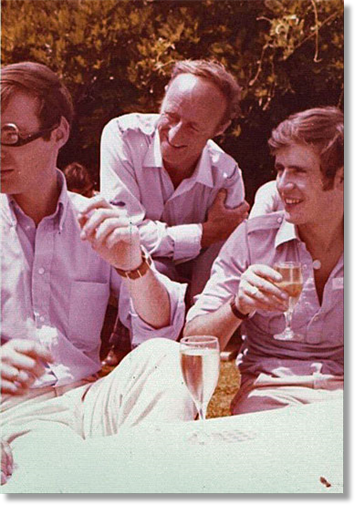
Seppelts Wine Tasting
Aussie Guide with the Long Legs
After a Few Glasses...
As it was, we had a relaxing day that Saturday and my good pal and myself had been invited by the Nimrod detachment to join them on a coach trip to Seppelts Winery in the Barossa Wine Valley. We were even picked up from the hotel; the coach was provided and driven by a RAAF driver. The hospitality was tremendous and the samples of wines we were given was superb.
All good things come to an end though and the following day saw the team heading back to the airfield to backload the Belfast.
All good things come to an end though and the following day saw the team heading back to the airfield to backload the Belfast.
The ground engineer came with us, we opened up ‘Hector’ and prepared the aircraft for loading. The UK load now appeared and looked impressive. Three containerised Sea Dart missiles, ten Ikara missiles and a Jindivik Target Drone. These Sea Darts were some of the first destined for the Royal Navy which went into service that year. The Ikara (Aboriginal word for ‘Throwing stick’) was a missile built in Australia and operated by the Royal Navy. It had a range of 10 miles and carried an attached torpedo which was then released when it landed. The Jindivik (Aboriginal word meaning ‘The Hunted one’) is also Australian built. It is a jet powered radio controlled drone and was flown primarily from RAE Aberporth, near Cardigan, for target use.
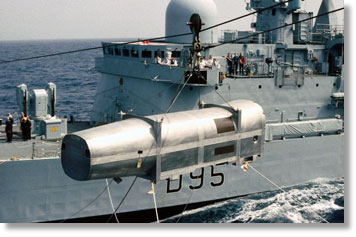
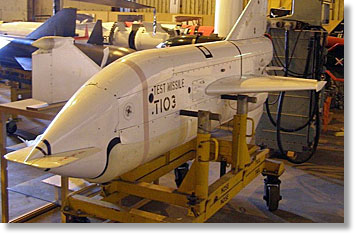
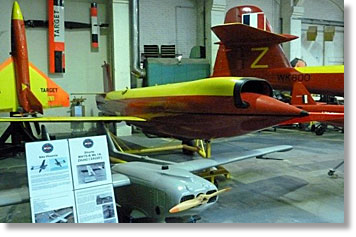
Sea Dart Missile
Jindivik Drone
Ikara Missile
All in all quite a ‘meaty’ load and a challenge to position on the aircraft with the limited loading aids we had. Eventually all was achieved safely and a good aircraft trim achieved. Sometime later the operating crew appeared and then after a fantastic 49hr break in Adelaide we headed back to Darwin. Once again we were met by the RAAF and the aircraft ‘put to bed’. This time though we weren’t gassed!
Our departure from Darwin was early evening and it was already dark. This time the RAAF handling party were more vocal in their sarcasm of the RAF. We had the last laugh though as at that time both my pal Bob, and myself drove VW Beetles. In our holdall we now had eight shiny hubcaps!
Once again we arrived at Tengah, Singapore. This time we were informed by the local movers that we were to leave our Belfast as they needed the payload. We were to be transferred to a regular VC10 schedule the next day back to Brize Norton. So after eight days with the same crew we bid our farewells in the hotel that night. We also met the other MAMS team who were on the Indonesian task and they informed us that they too were being transferred to the same VC10 the next day. Consequently we all travelled back to UK on VC10 XR806 staging through Gan, Masirah and Akrotiri on the way.
Our departure from Darwin was early evening and it was already dark. This time the RAAF handling party were more vocal in their sarcasm of the RAF. We had the last laugh though as at that time both my pal Bob, and myself drove VW Beetles. In our holdall we now had eight shiny hubcaps!
Once again we arrived at Tengah, Singapore. This time we were informed by the local movers that we were to leave our Belfast as they needed the payload. We were to be transferred to a regular VC10 schedule the next day back to Brize Norton. So after eight days with the same crew we bid our farewells in the hotel that night. We also met the other MAMS team who were on the Indonesian task and they informed us that they too were being transferred to the same VC10 the next day. Consequently we all travelled back to UK on VC10 XR806 staging through Gan, Masirah and Akrotiri on the way.
It was a fantastic trip and interesting task too. We arrived back at RAF Abingdon, tired and jet lagged on the Thursday. The next evening, Friday, was our regular squadron beer call. Before the bar was open I was summoned to see the OC, which usually meant a bollocking. This time I was told that the following Monday I was promoted to Sergeant!
The following week it transpired that the 203 Sqn Nimrod crew had won the competition. The aircraft concerned, XV250, was then ‘zapped’ with a red kangaroo on the rear of the fuselage. This marking remained there for years.
XV250 is still alive and is now located at the Yorkshire Air Museum (YAM) near York and in full working order. Unbeknownst to me, but on that crew was my later friend, Ray F. Ray made contact with me some 10 years ago and it transpires that he is one of the custodians of XV250 at the YAM.
The original aircrew and ground crew were having a reunion and he was after any photographs I had. I sent what I had, primarily taken on the Barossa Wine Valley trip. He later told me that when the Skipper spoke at the reunion he always remembered the young Australian female who stood on the table to brief us. When Ray did his presentation he produced a slide of that very same girl; this left the crowd quite speechless!
XV250 is still alive and is now located at the Yorkshire Air Museum (YAM) near York and in full working order. Unbeknownst to me, but on that crew was my later friend, Ray F. Ray made contact with me some 10 years ago and it transpires that he is one of the custodians of XV250 at the YAM.
The original aircrew and ground crew were having a reunion and he was after any photographs I had. I sent what I had, primarily taken on the Barossa Wine Valley trip. He later told me that when the Skipper spoke at the reunion he always remembered the young Australian female who stood on the table to brief us. When Ray did his presentation he produced a slide of that very same girl; this left the crowd quite speechless!
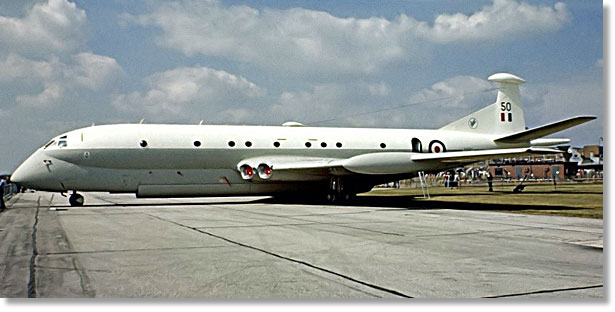
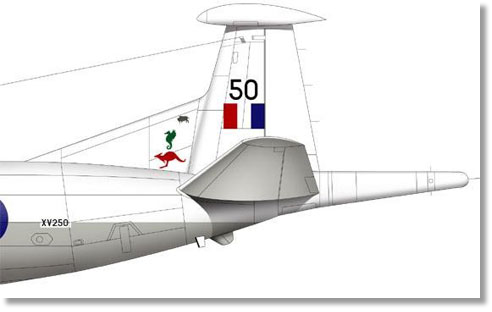
Nimrod XV250 of 203 Squadron
The Kangaroo Zap on the Tail after Winning

From: Ian Envis, Crowborough, East Sussex
Subject: Bob Dixon RIP
Dear Tony,
Subject: Bob Dixon RIP
Dear Tony,
The world of FaceBook has been full of condolences for the former Group Captain Bob Dixon OBE, RAF (Retd) who passed away on 14th April after a valiant fight against cancer.
Although a Supply, therefore Logistics Officer, his biggest career interest and fame stems from his time as a MOVER, in particular as OC UKMAMS in the early Eighties and subsequently upon retirement as OC 4624 (County of Oxford) Movements Squadron where he became the 2nd RAuxAF Wg Cdr in charge (followed Richard Mighal) and stamped his persona along with a huge belief in high professional standards coupled with incredible interest in the personal life of all Squadron personnel and their families.
Although a Supply, therefore Logistics Officer, his biggest career interest and fame stems from his time as a MOVER, in particular as OC UKMAMS in the early Eighties and subsequently upon retirement as OC 4624 (County of Oxford) Movements Squadron where he became the 2nd RAuxAF Wg Cdr in charge (followed Richard Mighal) and stamped his persona along with a huge belief in high professional standards coupled with incredible interest in the personal life of all Squadron personnel and their families.

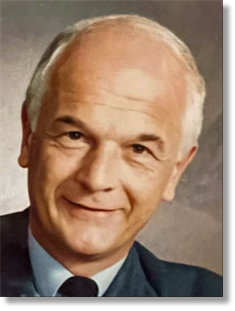
Bob joined the RAF as a Cranwell Cadet, was commissioned as an Equipment Officer (which morphed into Supply in the 70's) and then covered the world at various times in both Supply & Movements Jobs, Junior Mover in Singapore, as a staff officer both MOD Mov Branch & HQ38Grp, Petroleum Directorate, a Staff Officer at The Nigerian Armed Forces Staff College, a Flight Commander for cadets at Cranwell, attended Manchester University to do their 1 year intense course for Suppliers and commanded 16MU Stafford. As those that knew Bob or served under him, he enjoyed the formidable & loving support of his adorable wife Sue who was often a strong link on welfare for his ''troops''.
Throughout a varied and successful career, Bob also found time to be heavily involved in Charities or RAF Welfare being the President of RAFA Swindon, actively involved in Project Propeller - provides a social link for former WWII Aircrew with the very last meeting scheduled for June 2022, to which Bob & Sue were targeting). Mustn't forget he was at one time The Secretary of the RAF Hockey Association.
Bob's power of the written word was put to good use as he was the PR & Media link for the Royal International Air Show (RIAT) and had links across Europe regarding all matters ''airshows'' and nostalgic/historic aircraft. His flights in the Red Bull support aircraft were worthy of several hours of chat (with wine)
Given how we all enjoy a read of Tony G's Monthly Newsletter it is worth noting that Bob instigated the formation of the 4624Sqn Association which has 100+ members and tries - like Tony does, in keeping the old & bold in particular up to date on RAuxAF Oggie news and activities.
Finally, Bob & Sue had a wonderful rapport with many former WO Movers and their wives and on several times a year they met for lunch, some Red Wine, Bob - being an expect on ''reds'' where they enjoyed a good natter, checked on the health and welfare of all Ex-Movers and ensured the world was safe.
Having outlined the career and the basic personality of Bob it is most important to finish by stating he was an inspiration and a first class leader to just about ALL MOVERS he ever had contact with. Never frightened to stop senior officers in their tracks, he mentored me, and many others giving sound advise or an appropriate steer in dealing with a service or personal matter.
To Sue and the extended family, our love, thoughts and prayers plus sincere condolences.
To Bob - Blue Skies mate. RIP
Ian Envis
Current President 4624Sqn Association
An Old and Bold former Mover
Throughout a varied and successful career, Bob also found time to be heavily involved in Charities or RAF Welfare being the President of RAFA Swindon, actively involved in Project Propeller - provides a social link for former WWII Aircrew with the very last meeting scheduled for June 2022, to which Bob & Sue were targeting). Mustn't forget he was at one time The Secretary of the RAF Hockey Association.
Bob's power of the written word was put to good use as he was the PR & Media link for the Royal International Air Show (RIAT) and had links across Europe regarding all matters ''airshows'' and nostalgic/historic aircraft. His flights in the Red Bull support aircraft were worthy of several hours of chat (with wine)
Given how we all enjoy a read of Tony G's Monthly Newsletter it is worth noting that Bob instigated the formation of the 4624Sqn Association which has 100+ members and tries - like Tony does, in keeping the old & bold in particular up to date on RAuxAF Oggie news and activities.
Finally, Bob & Sue had a wonderful rapport with many former WO Movers and their wives and on several times a year they met for lunch, some Red Wine, Bob - being an expect on ''reds'' where they enjoyed a good natter, checked on the health and welfare of all Ex-Movers and ensured the world was safe.
Having outlined the career and the basic personality of Bob it is most important to finish by stating he was an inspiration and a first class leader to just about ALL MOVERS he ever had contact with. Never frightened to stop senior officers in their tracks, he mentored me, and many others giving sound advise or an appropriate steer in dealing with a service or personal matter.
To Sue and the extended family, our love, thoughts and prayers plus sincere condolences.
To Bob - Blue Skies mate. RIP
Ian Envis
Current President 4624Sqn Association
An Old and Bold former Mover

From: Gill Howie, via Squadron Prints - FaceBook
Subject: Bob Dixon
It was with deep sadness that I received the news about the passing of one of our AIRSHOW GREATS - not a performer per se, although he could give a great speech and command an audience, but a man, without whom, many of us would probably not have managed to stage our own airshows or events.
To Group Captain Bob Dixon OBE RAF Retd, airshows were a passion. From this passion he offered encouragement and advice but most of all, he demonstrated his belief in the person. I was a young aviation enthusiast, desperate to stage an aviation event in Scotland. With Bob’s expert assistance, along with many others in the airshow fraternity, I achieved my dream with his help and wealth of knowledge. I got to know Bob whilst undertaking my Flying Display Directors Course with many other well-known Airshow people and did my 'Shadowing' at the Malta Airshow. I was apprehensive and considered myself to be “well out of my depth”, however Bob set my mind at ease. I joined the European Airshow Council and attended many conventions. Although hard work, through Bob and others, I learnt a great deal, but these events were always great fun as well. Bob’s wife Sue was always there by his side and always the perfect hostess. They both cared about people, they cared about airshows and boy, did they care about each other! Sadly, Bob passed away on Thursday 14 April 2022 after a short illness.
Bob - I will miss you with all my heart and will never forget your kindness, your words of encouragement and the laughter I shared with you. I loved chatting with you at home and abroad, especially at those social gatherings with Joe in Malta along with our other dear airshow friends who often attended.
Goodnight, dear Bob - very many in the airshow world will miss you desperately. Rest in Peace Sir!
To Sue - we are all here for you and the team here at Squadron Prints send you our heartfelt sympathy - much love to you!
Subject: Bob Dixon
It was with deep sadness that I received the news about the passing of one of our AIRSHOW GREATS - not a performer per se, although he could give a great speech and command an audience, but a man, without whom, many of us would probably not have managed to stage our own airshows or events.
To Group Captain Bob Dixon OBE RAF Retd, airshows were a passion. From this passion he offered encouragement and advice but most of all, he demonstrated his belief in the person. I was a young aviation enthusiast, desperate to stage an aviation event in Scotland. With Bob’s expert assistance, along with many others in the airshow fraternity, I achieved my dream with his help and wealth of knowledge. I got to know Bob whilst undertaking my Flying Display Directors Course with many other well-known Airshow people and did my 'Shadowing' at the Malta Airshow. I was apprehensive and considered myself to be “well out of my depth”, however Bob set my mind at ease. I joined the European Airshow Council and attended many conventions. Although hard work, through Bob and others, I learnt a great deal, but these events were always great fun as well. Bob’s wife Sue was always there by his side and always the perfect hostess. They both cared about people, they cared about airshows and boy, did they care about each other! Sadly, Bob passed away on Thursday 14 April 2022 after a short illness.
Bob - I will miss you with all my heart and will never forget your kindness, your words of encouragement and the laughter I shared with you. I loved chatting with you at home and abroad, especially at those social gatherings with Joe in Malta along with our other dear airshow friends who often attended.
Goodnight, dear Bob - very many in the airshow world will miss you desperately. Rest in Peace Sir!
To Sue - we are all here for you and the team here at Squadron Prints send you our heartfelt sympathy - much love to you!

From: Kit Ayers, Stow-on-the-Wold, Glos
Subject: RE: Gp Capt Bob Dixon OBE (Retd) - as Cargo Officer Changi
Hi Tony,
Subject: RE: Gp Capt Bob Dixon OBE (Retd) - as Cargo Officer Changi
Hi Tony,
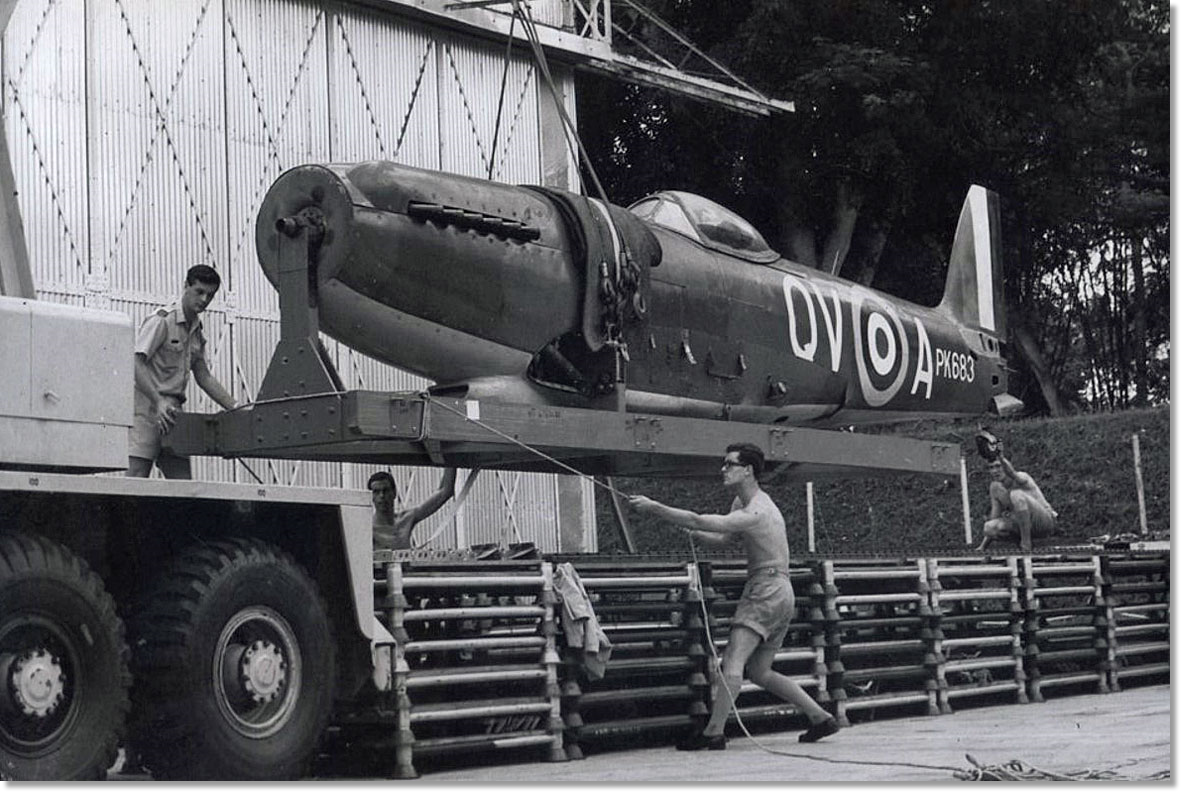
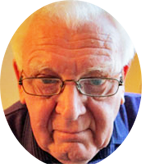
The load concerned was the Changi gate guardian Spitfire which was being sent back to UK to a museum as part of the rundown in early 1971. Bob is top left. I am not sure who the others are. I was at HQFEAF on the Mov Staff which included work on both the withdrawal hence involvement with Changi Station AMS and also the post withdrawal air movements organisation (Tengah).
At the start of 1971 the formal stance was that all British Forces were to be out of Singapore and Malaysia by the 31st December. This changed after the General Election in July when it was announced by the new government that there would be a residual British element in the ANZUK force. Because of the lateness of this announcement which ran across the real estate and major equipment disposal / withdrawal programme it took a lot of effort to find sufficient for the new Tengah set up and thus maintain continuity of operation!
Peter Holland was sent out from UK to be the new SAMO at Tengah as a squadron leader. He was given the badges of rank but not the pay until the new establishment was approved which was some time after it went live!
The formal closure of HQFEAF was on 1 Nov 71 and Changi about 6 weeks after that. I returned on Guy Fawkes night having handed over the Air Cdrs FEAF Block to the Singapore Armed Forces – I was the inventory holder.
Kit
At the start of 1971 the formal stance was that all British Forces were to be out of Singapore and Malaysia by the 31st December. This changed after the General Election in July when it was announced by the new government that there would be a residual British element in the ANZUK force. Because of the lateness of this announcement which ran across the real estate and major equipment disposal / withdrawal programme it took a lot of effort to find sufficient for the new Tengah set up and thus maintain continuity of operation!
Peter Holland was sent out from UK to be the new SAMO at Tengah as a squadron leader. He was given the badges of rank but not the pay until the new establishment was approved which was some time after it went live!
The formal closure of HQFEAF was on 1 Nov 71 and Changi about 6 weeks after that. I returned on Guy Fawkes night having handed over the Air Cdrs FEAF Block to the Singapore Armed Forces – I was the inventory holder.
Kit

From: Ian Envis, Crowborough, East Sussex
Subject: Bob Dixon Farewell - Update Donation and Food Allergies
I now have the details of Sue Dixon's chosen Charity for donations in memory of Bob as there are no flowers/wreaths.
Donations:
Prospect Hospice
Moorhead Road
Wroughton
Swindon, Wilts SN4 BY
Tel: +44 1793 813355
Donate via email:
https://www.propect-hospice.net/your-prospect/donate-form/
Collection Box: Will be at the exit from the Crematorium Chapel and also at the wake venue RWB RFC Club House.
Allergies - should anybody attending have any food allergies could they please advise me via: envistribe@msn.com
You may circulate this email as you see fit to catch Bob's huge list of friends/colleagues.
Cheers Ian
President 4624Sqn Association
Subject: Bob Dixon Farewell - Update Donation and Food Allergies
I now have the details of Sue Dixon's chosen Charity for donations in memory of Bob as there are no flowers/wreaths.
Donations:
Prospect Hospice
Moorhead Road
Wroughton
Swindon, Wilts SN4 BY
Tel: +44 1793 813355
Donate via email:
https://www.propect-hospice.net/your-prospect/donate-form/
Collection Box: Will be at the exit from the Crematorium Chapel and also at the wake venue RWB RFC Club House.
Allergies - should anybody attending have any food allergies could they please advise me via: envistribe@msn.com
You may circulate this email as you see fit to catch Bob's huge list of friends/colleagues.
Cheers Ian
President 4624Sqn Association
This Newsletter is Dedicated
to the Memories of:
Bob Dixon (RAF)
Dave Giles (RAF)
Dixie Dean (RAF)
Dan Brinklow (RCAF)
Jim Cunningham (RAF)
Ian "Wee Foddy" Newlands (RAF)
to the Memories of:
Bob Dixon (RAF)
Dave Giles (RAF)
Dixie Dean (RAF)
Dan Brinklow (RCAF)
Jim Cunningham (RAF)
Ian "Wee Foddy" Newlands (RAF)
Tony Gale
ukmamsoba@gmail.com
If you wish to make a donation,
you may use the above e-mail
through PayPal.
.
ukmamsoba@gmail.com
If you wish to make a donation,
you may use the above e-mail
through PayPal.
.







